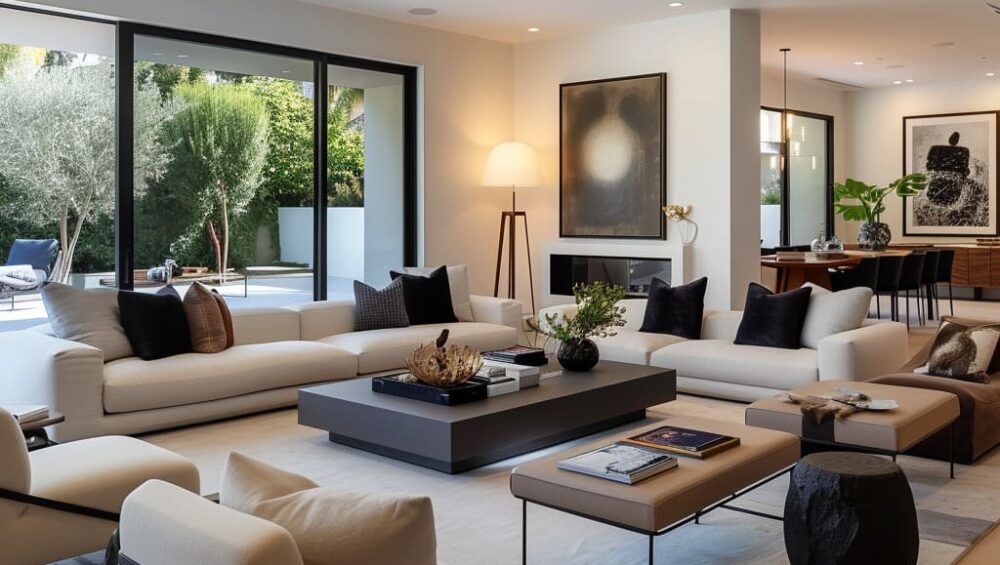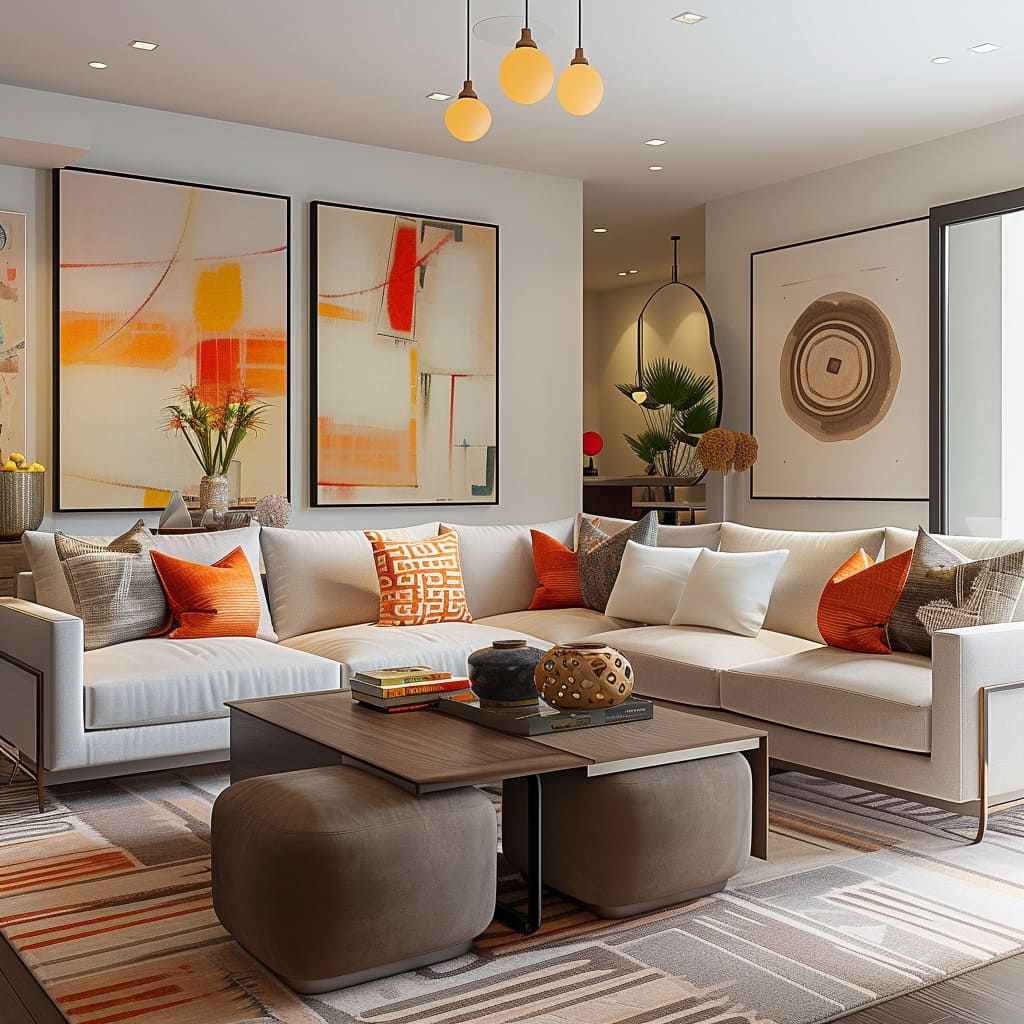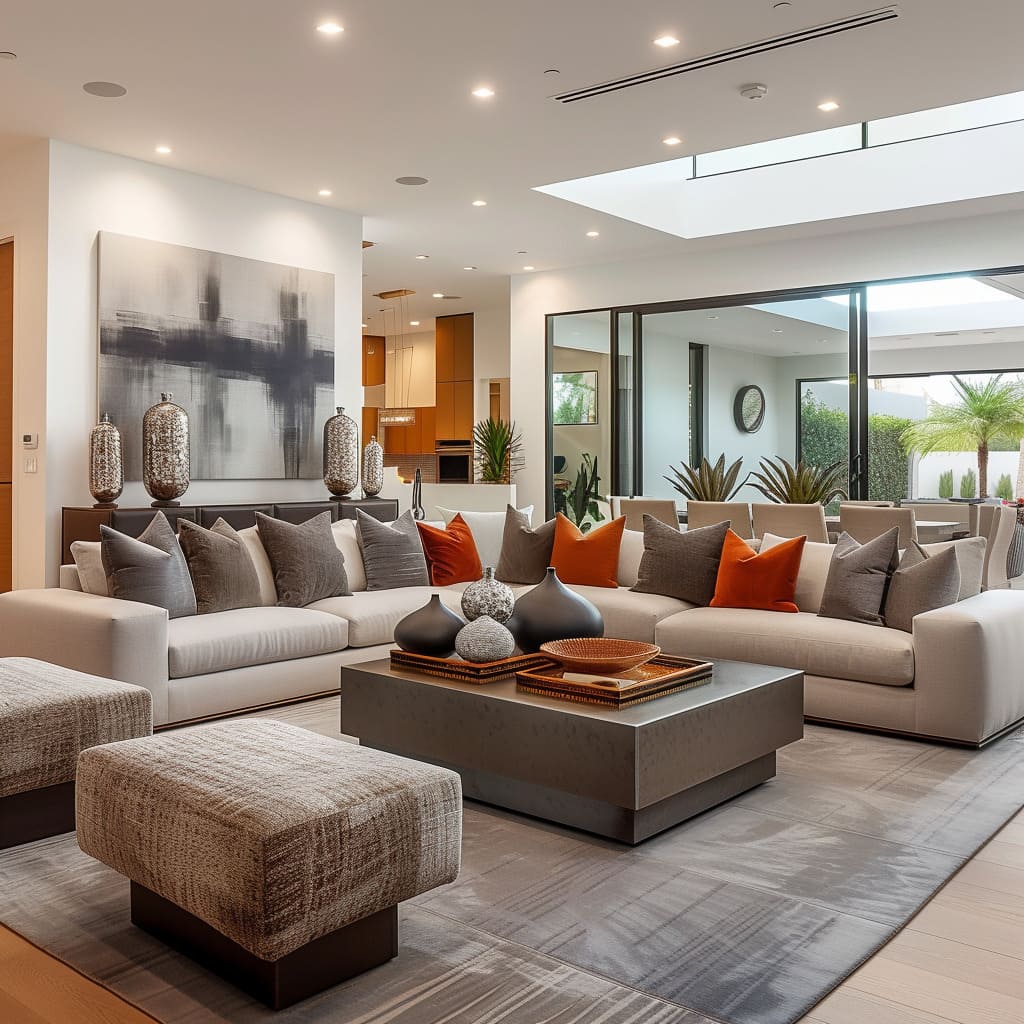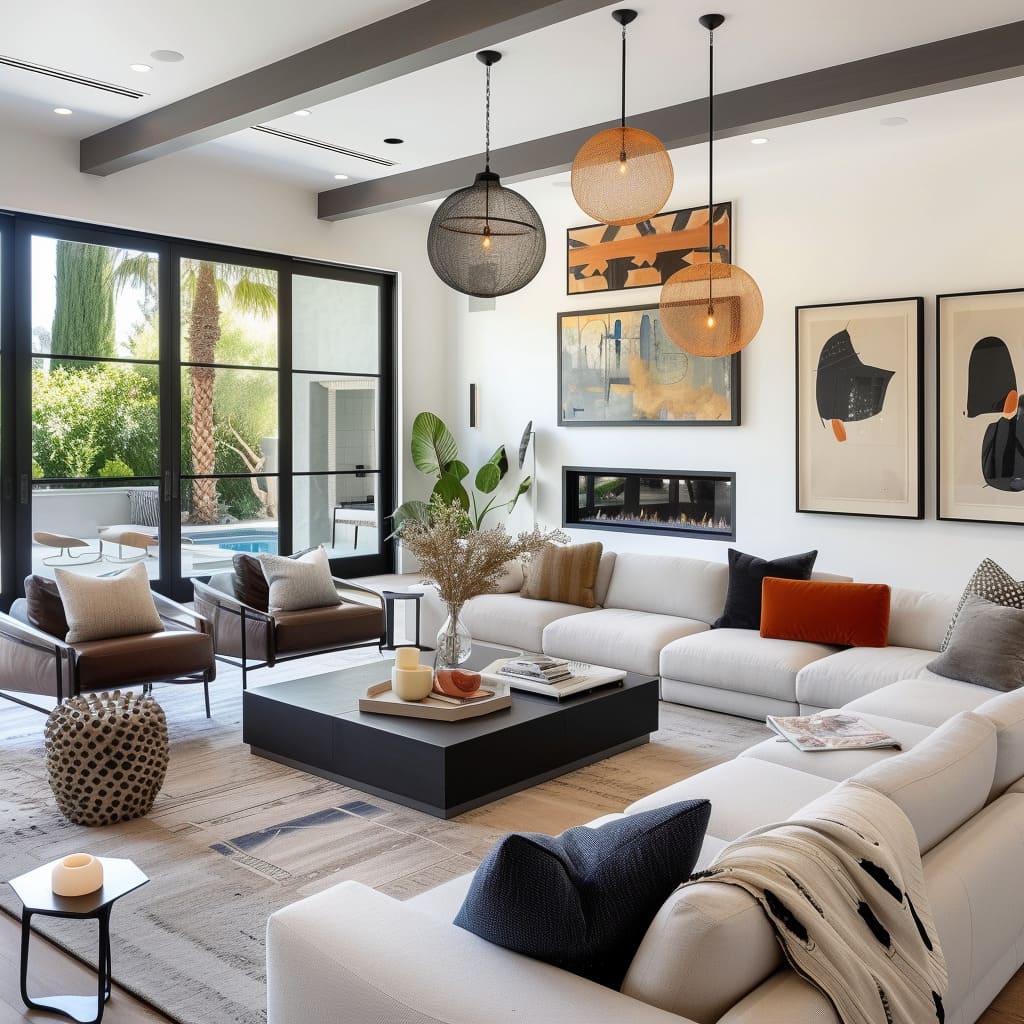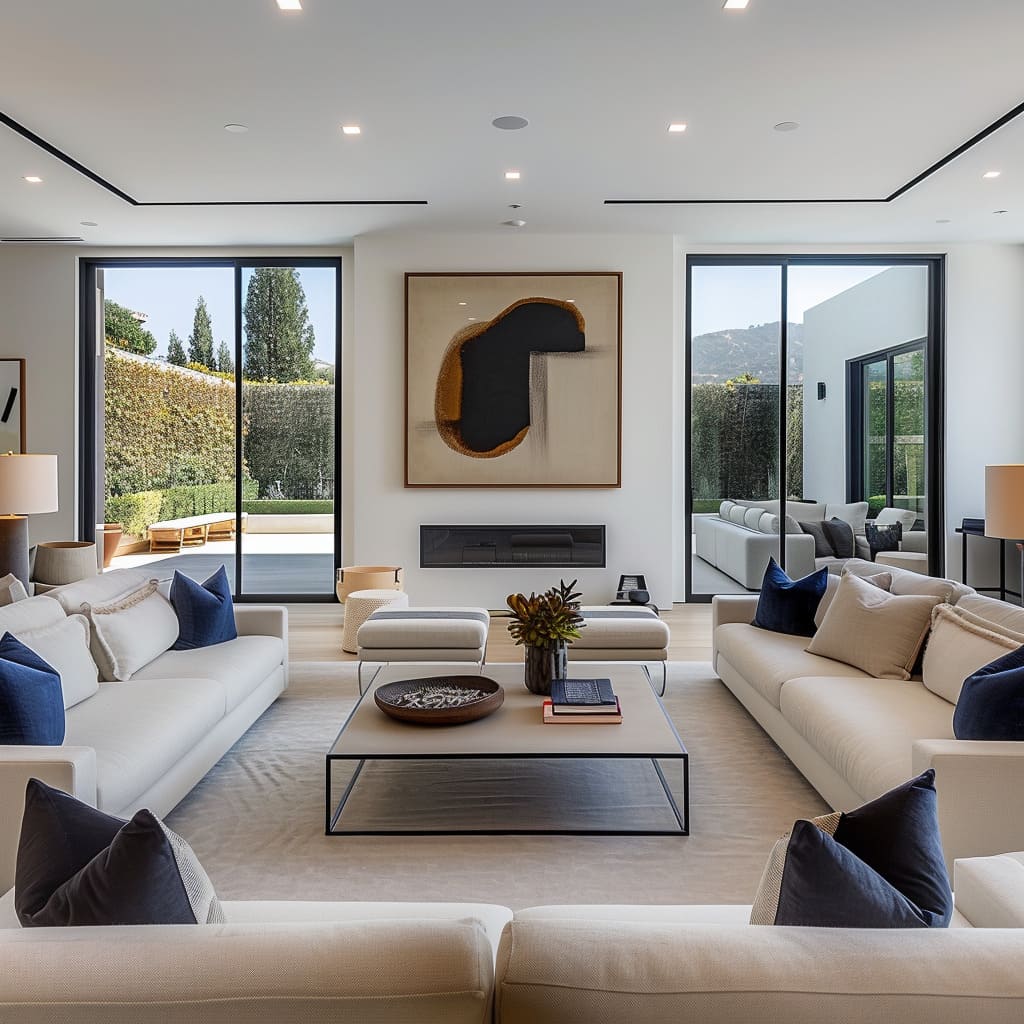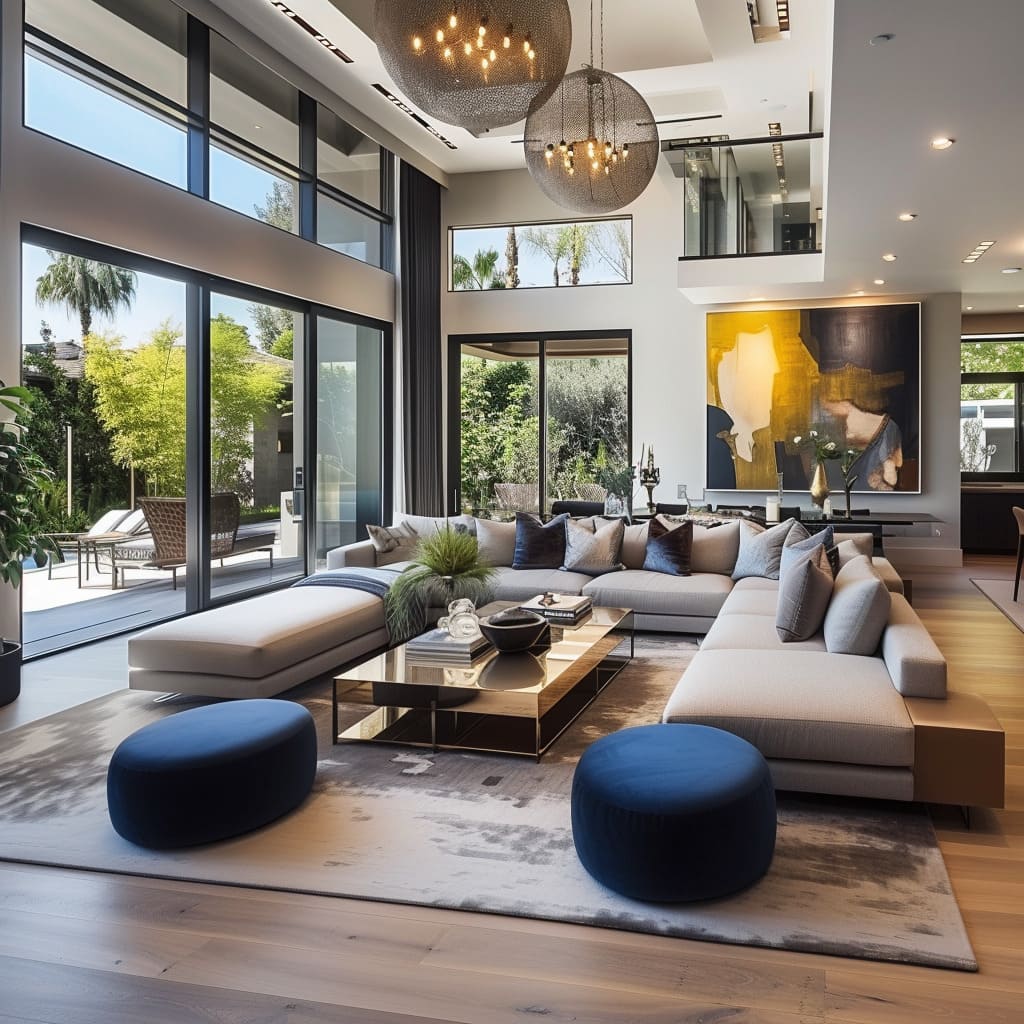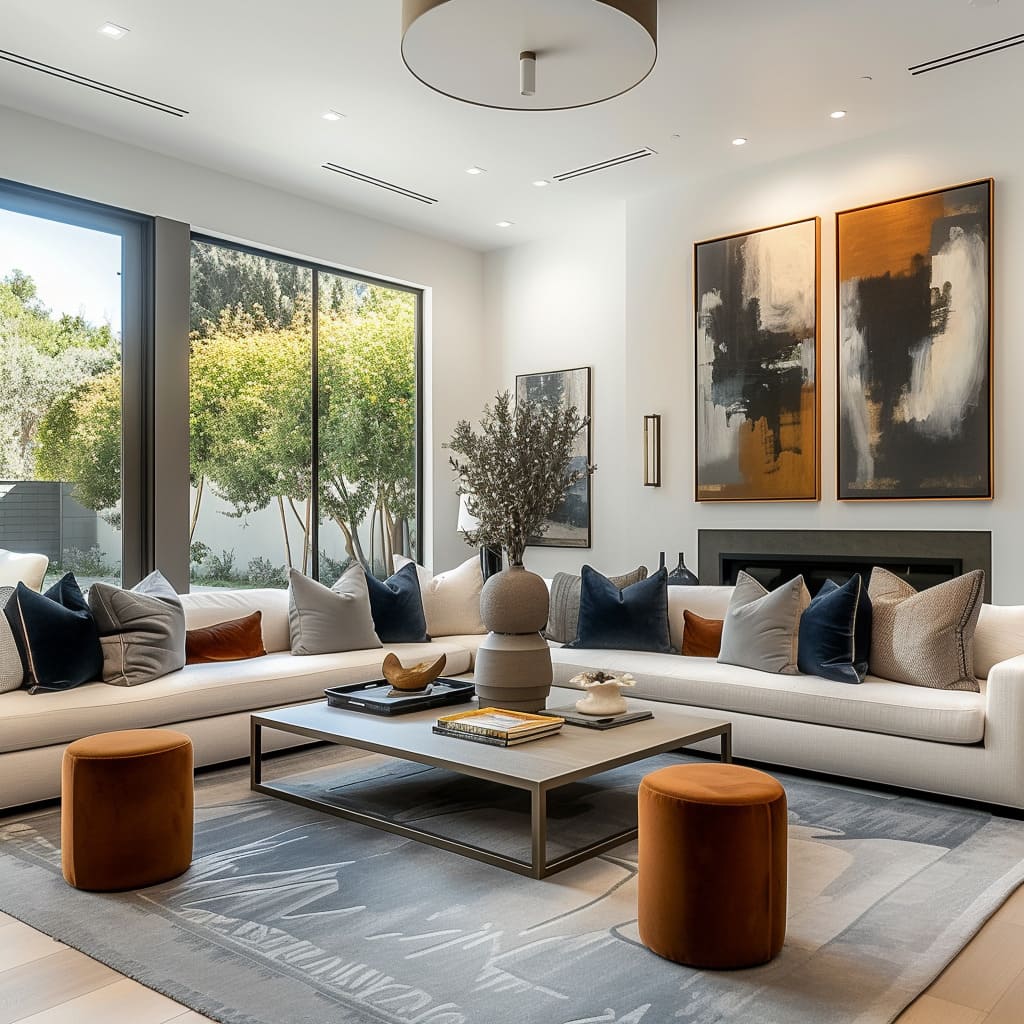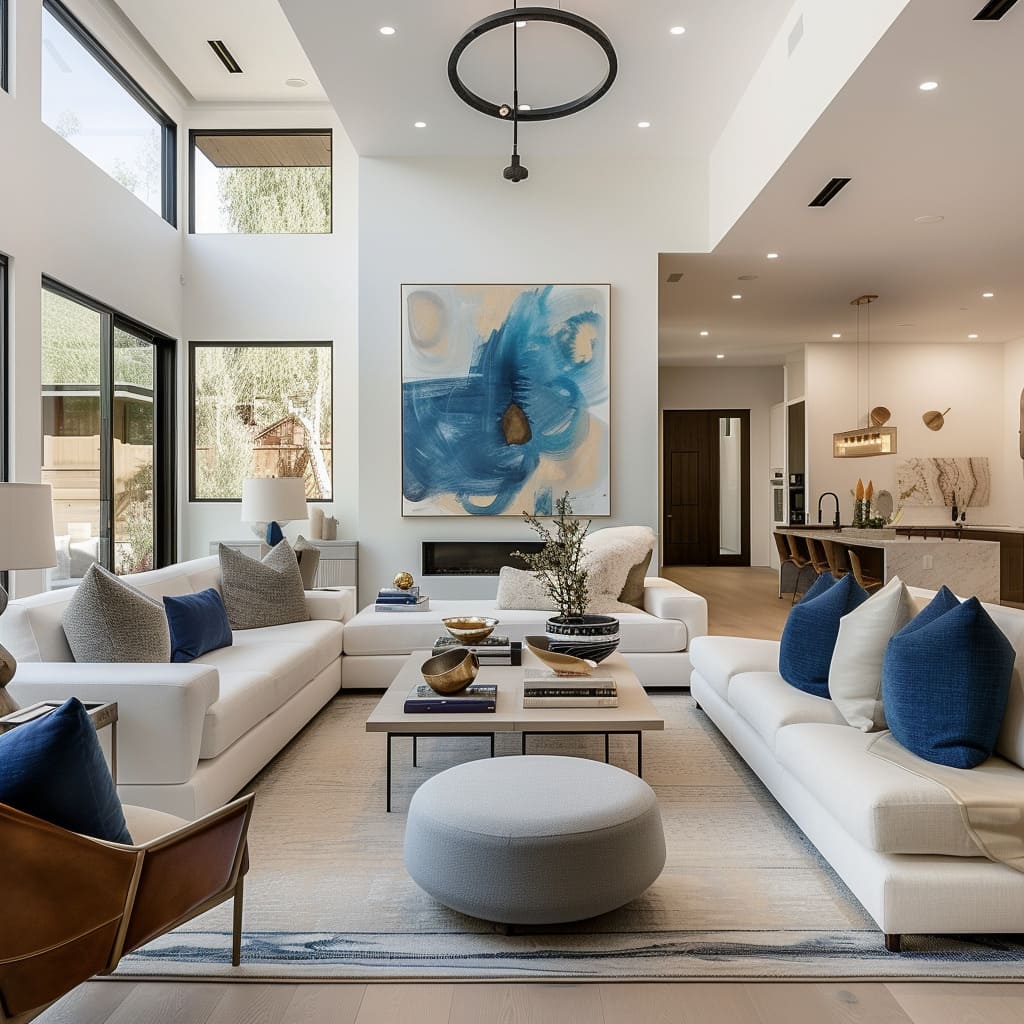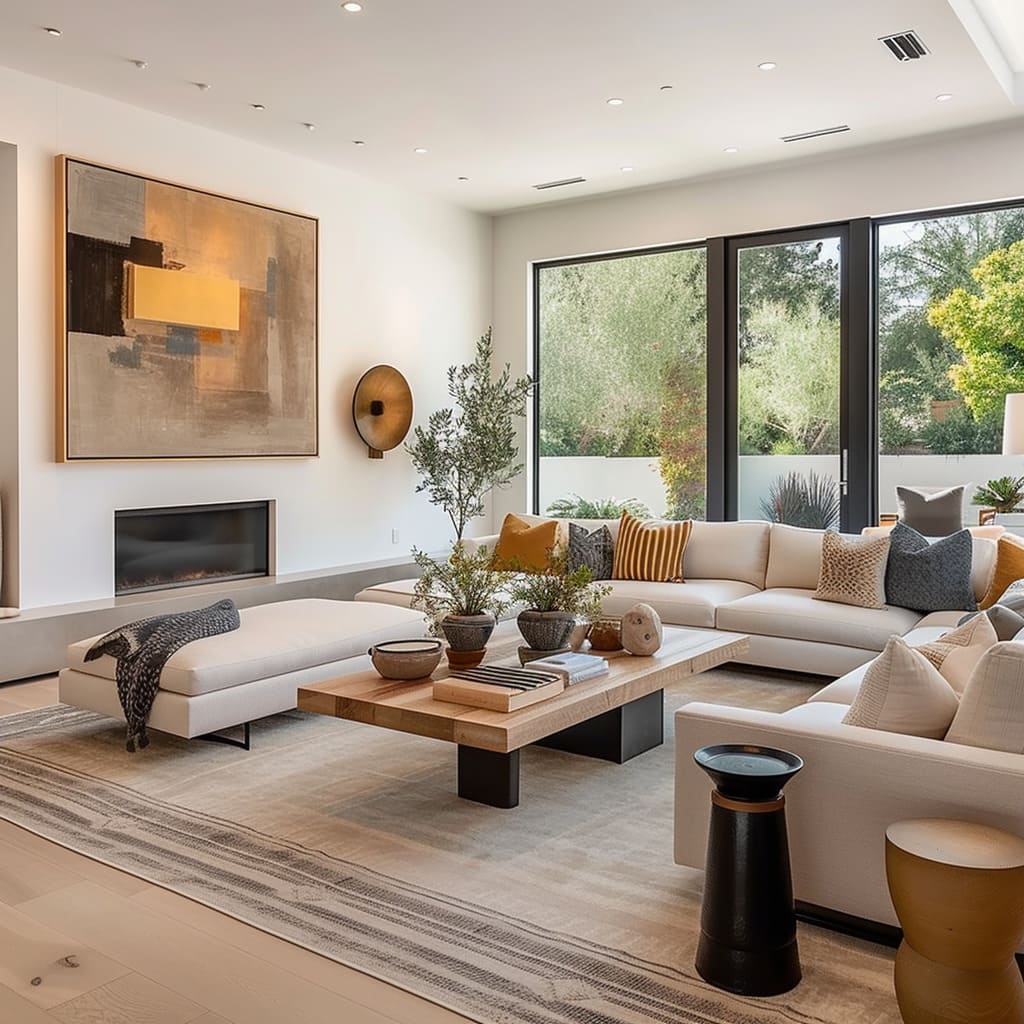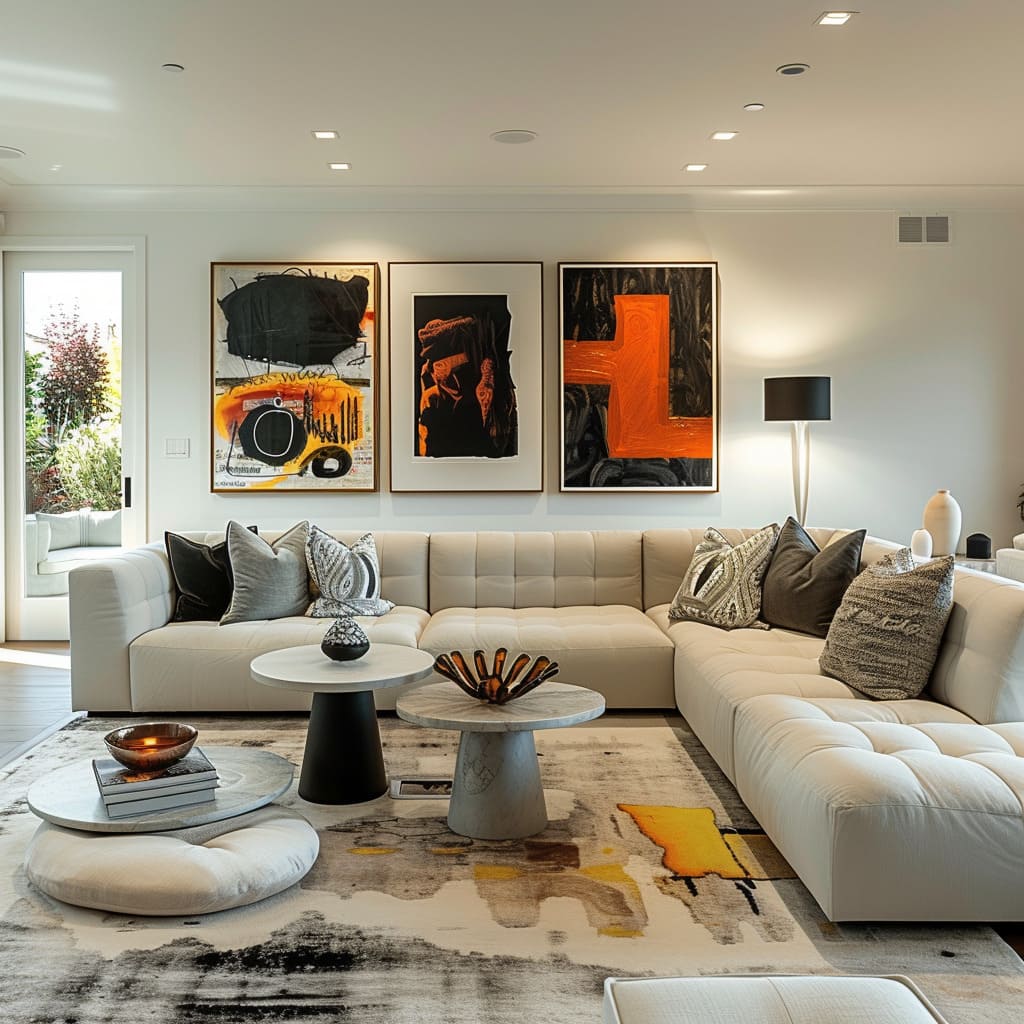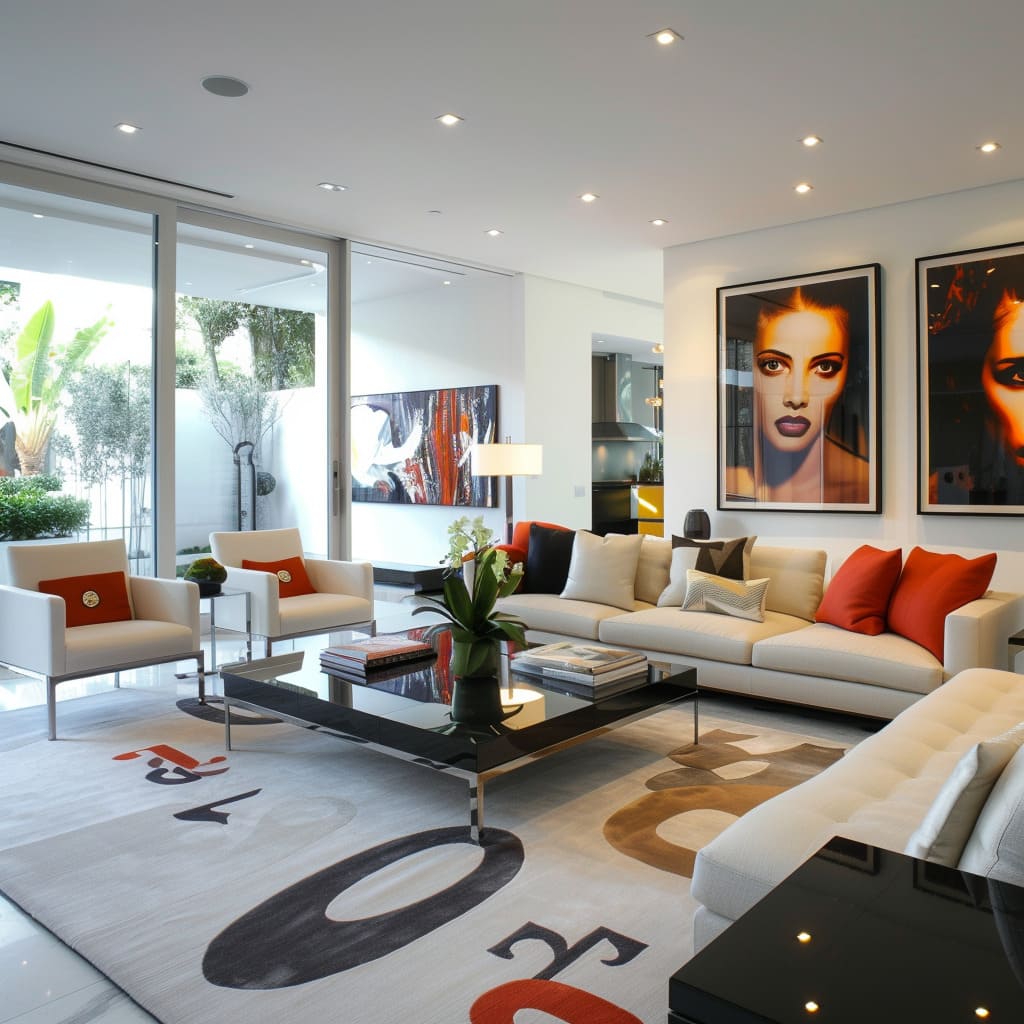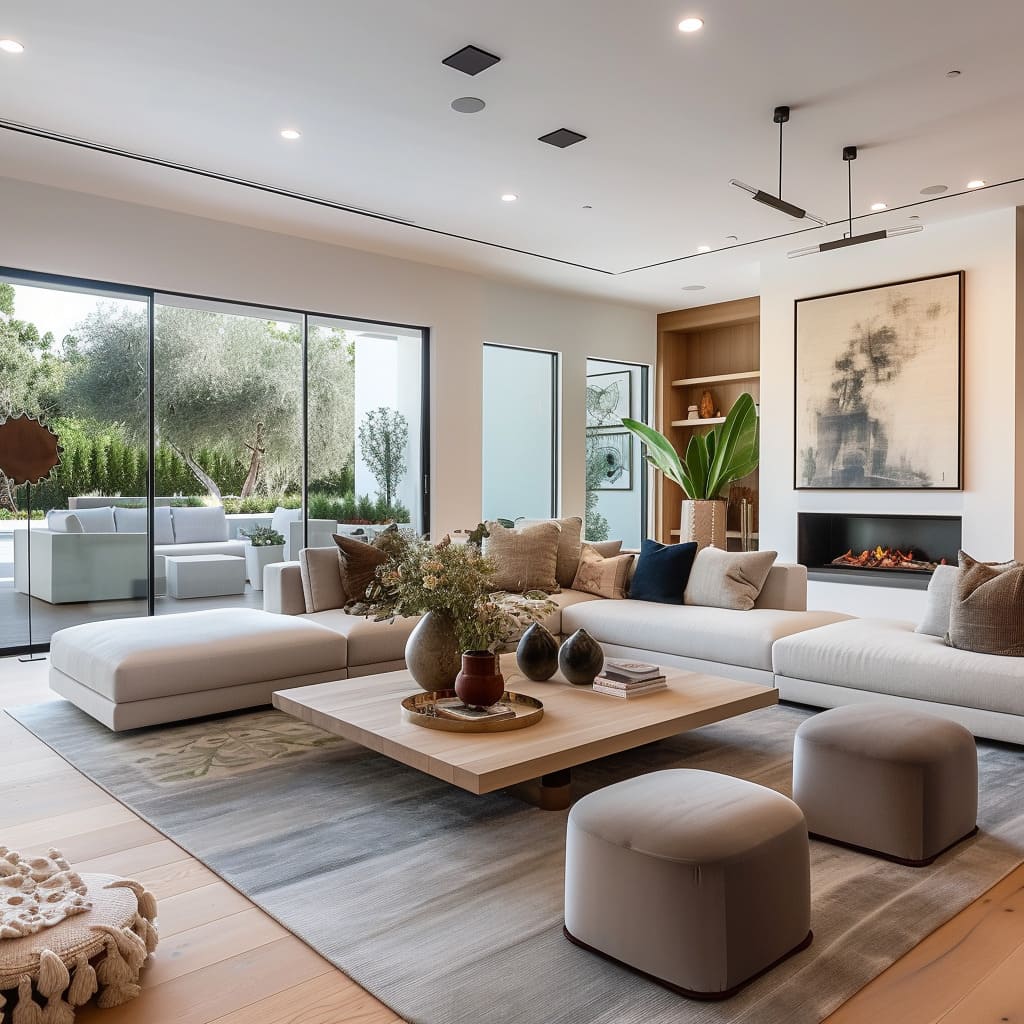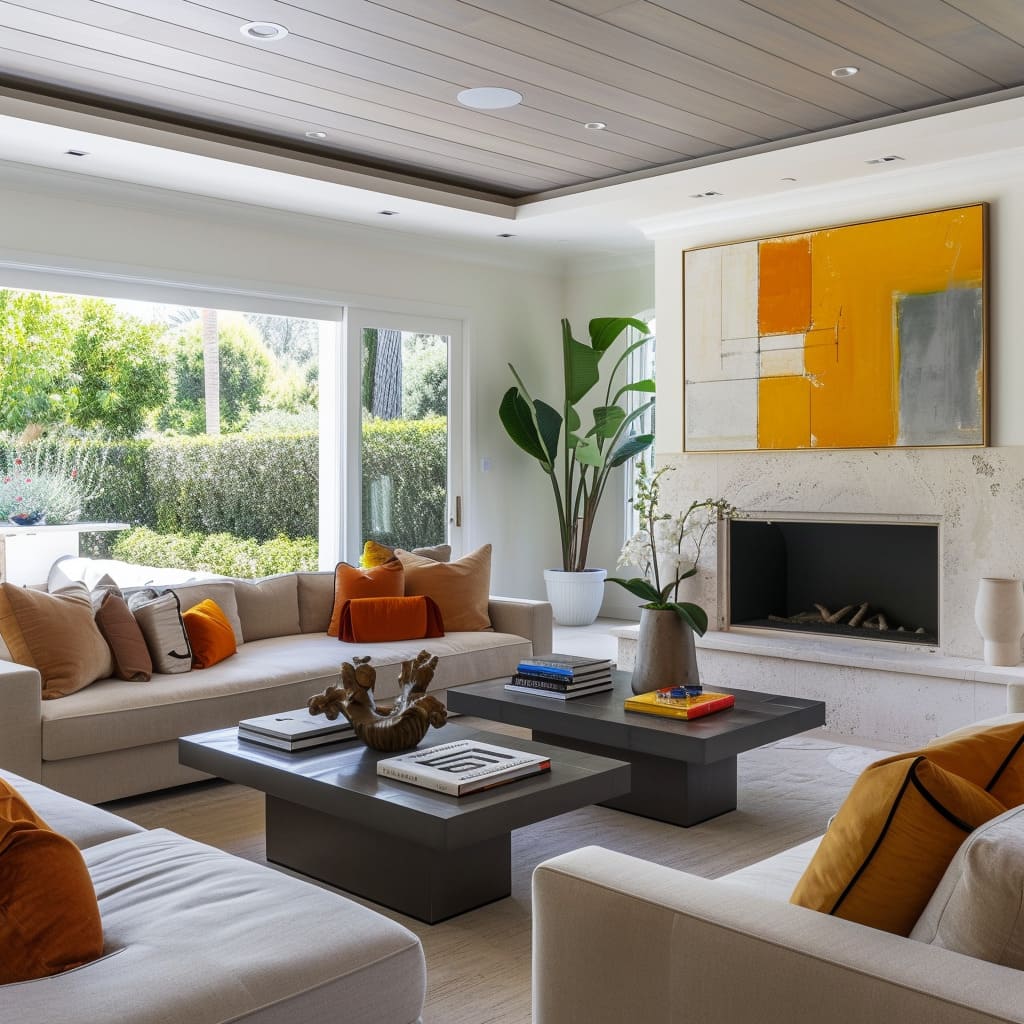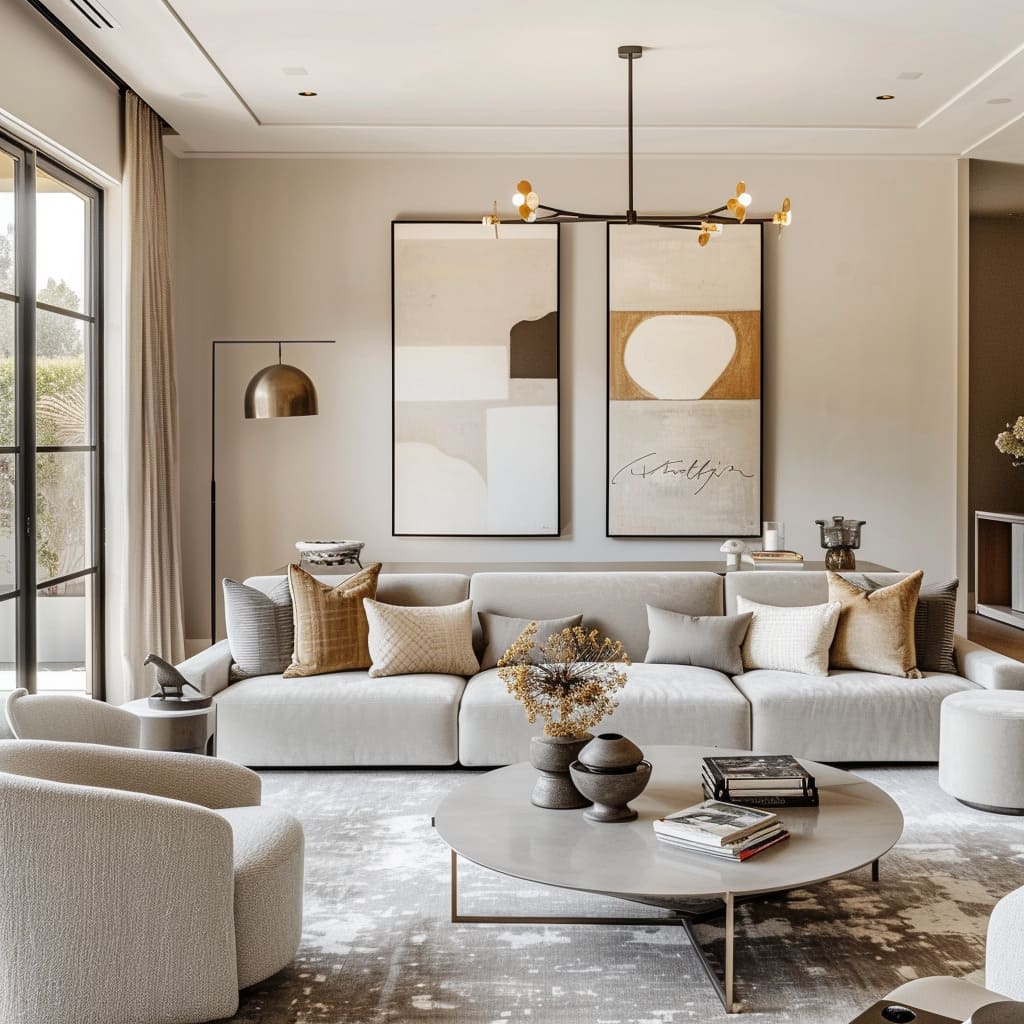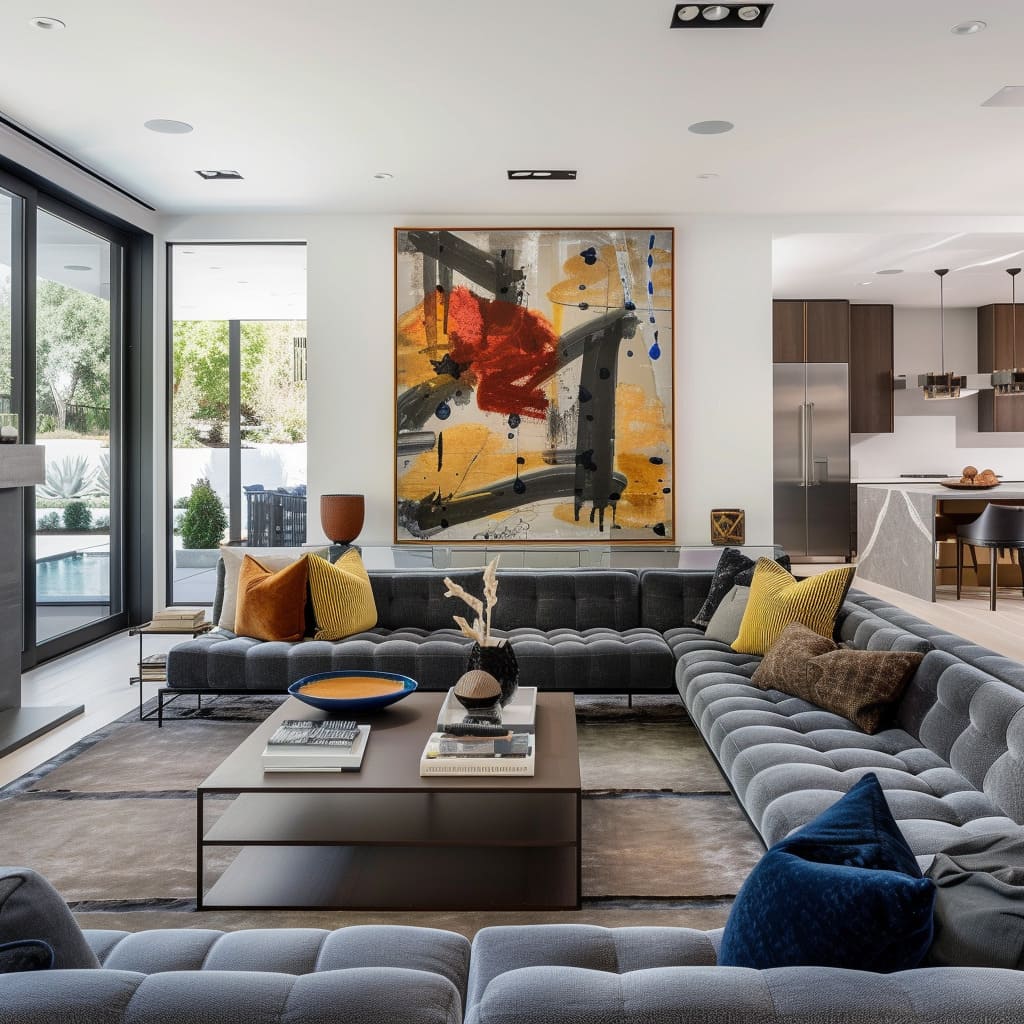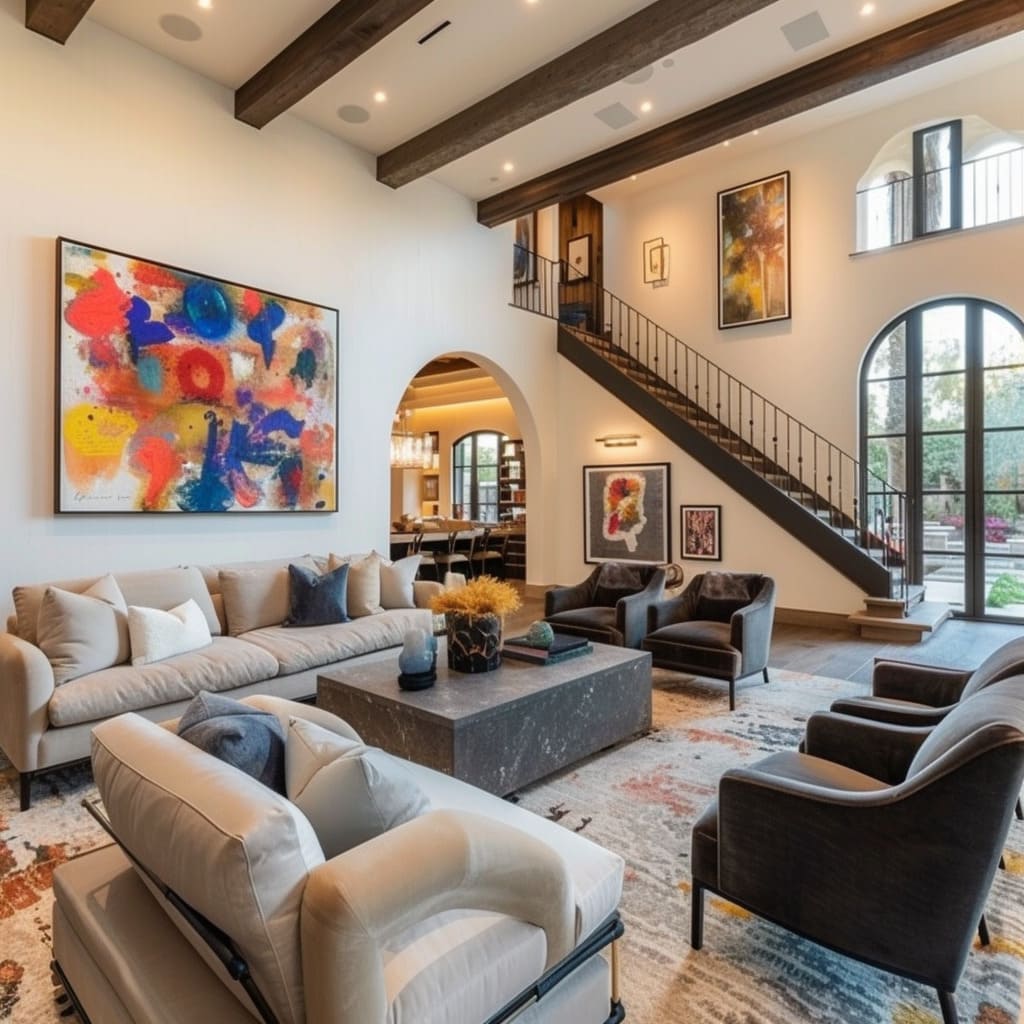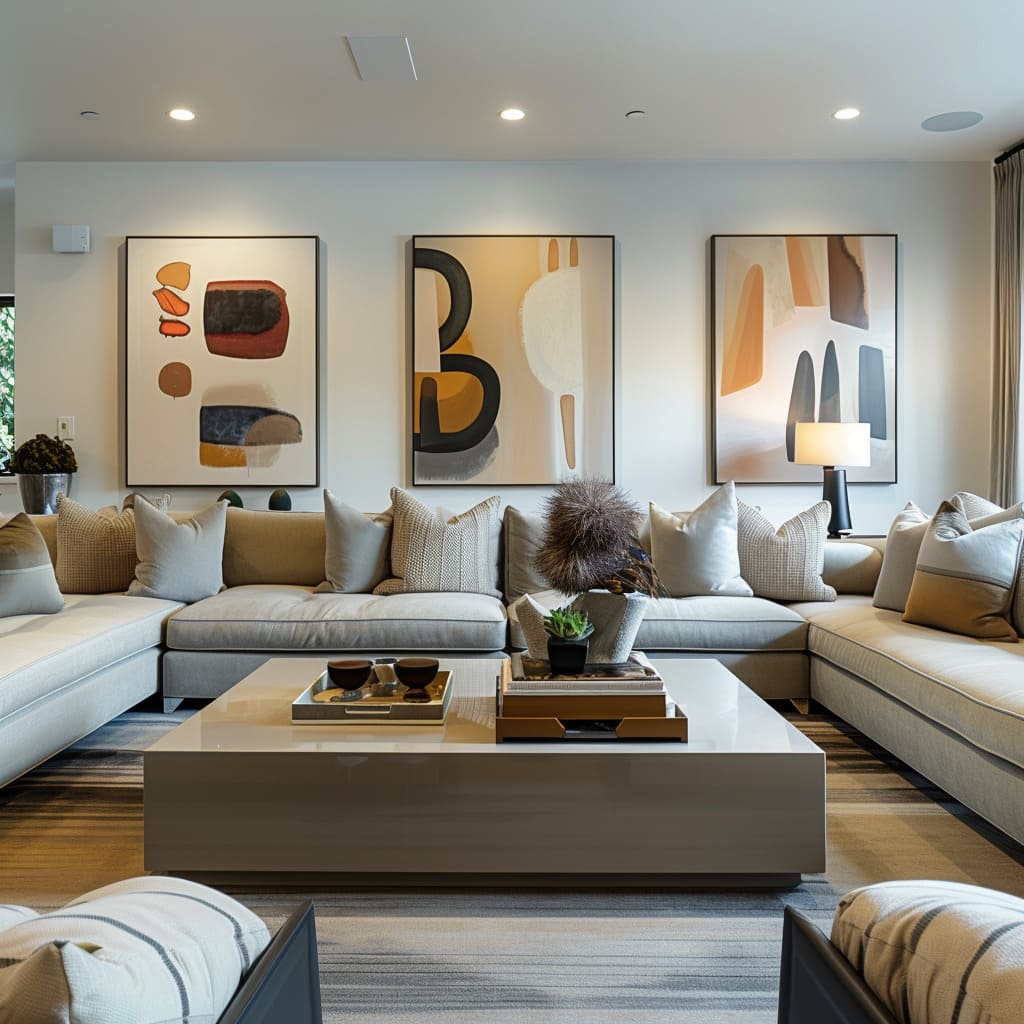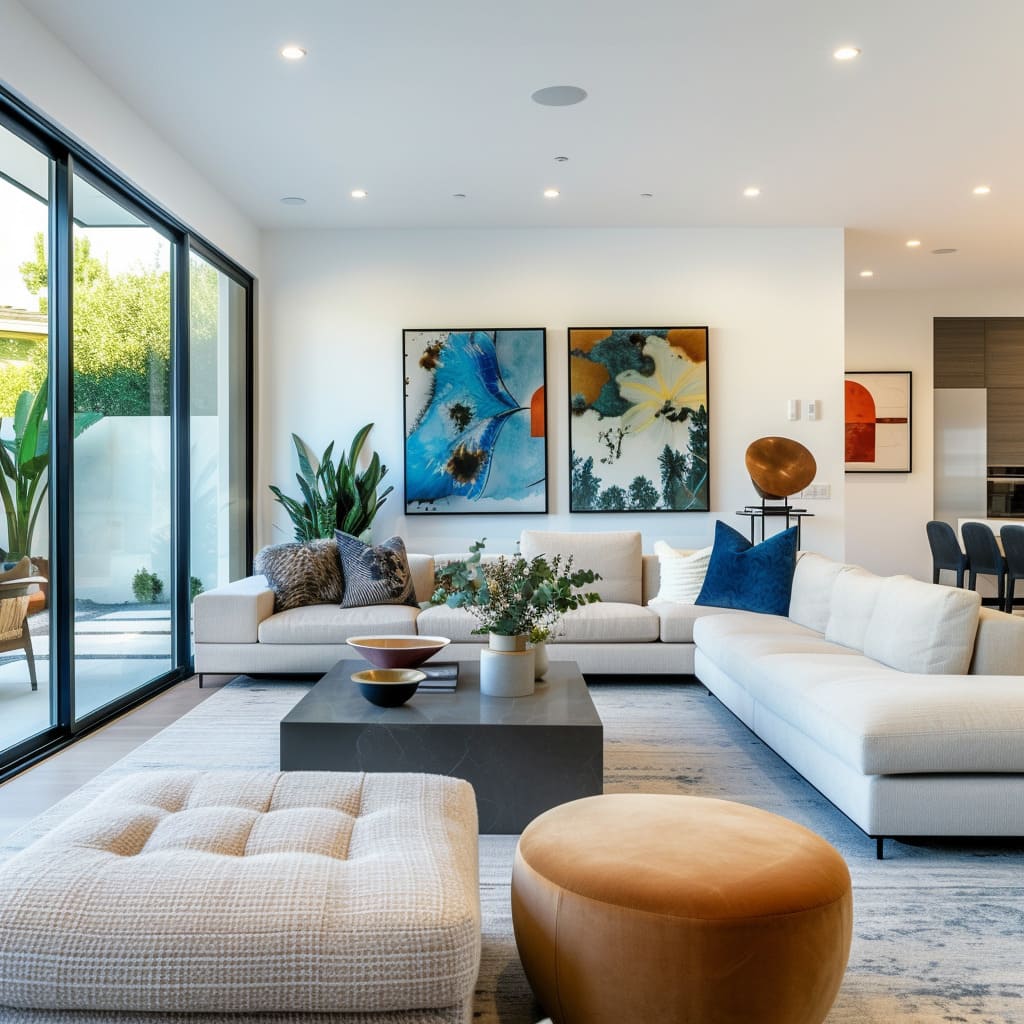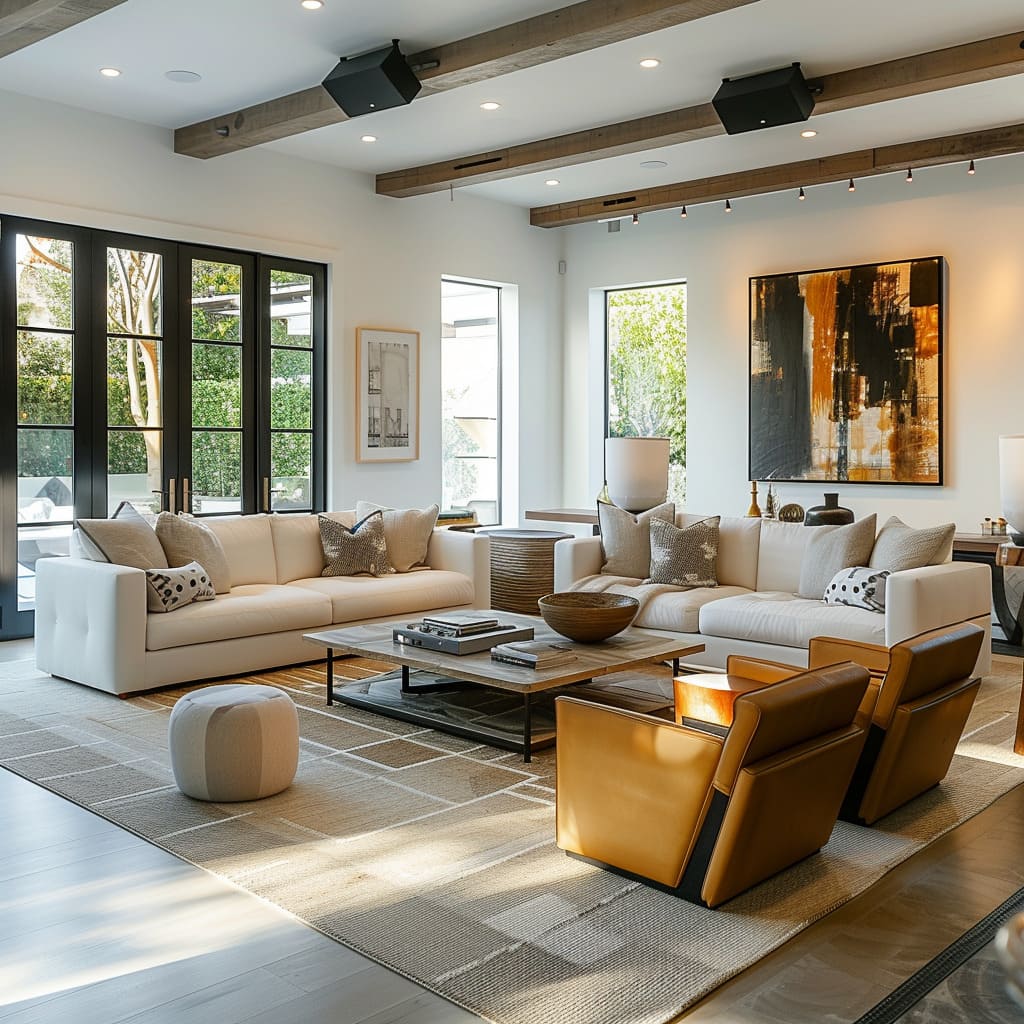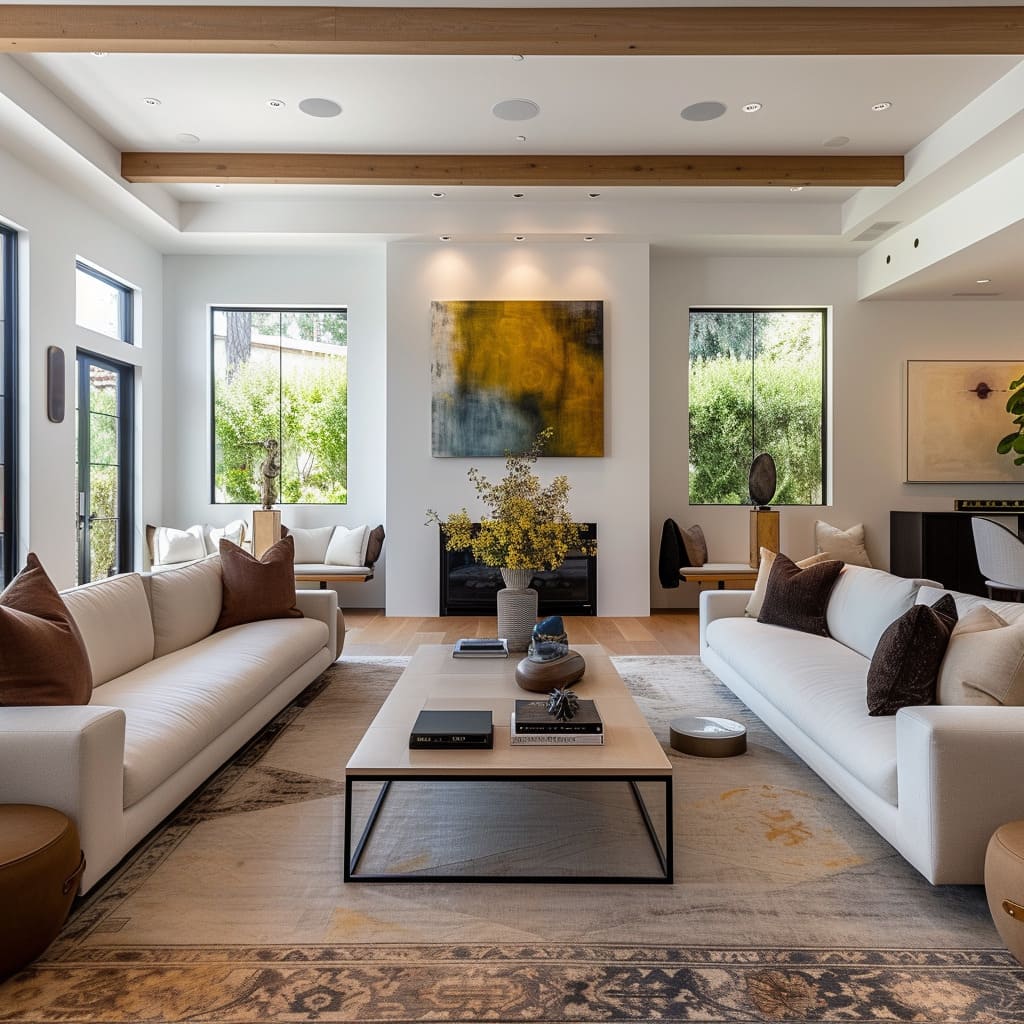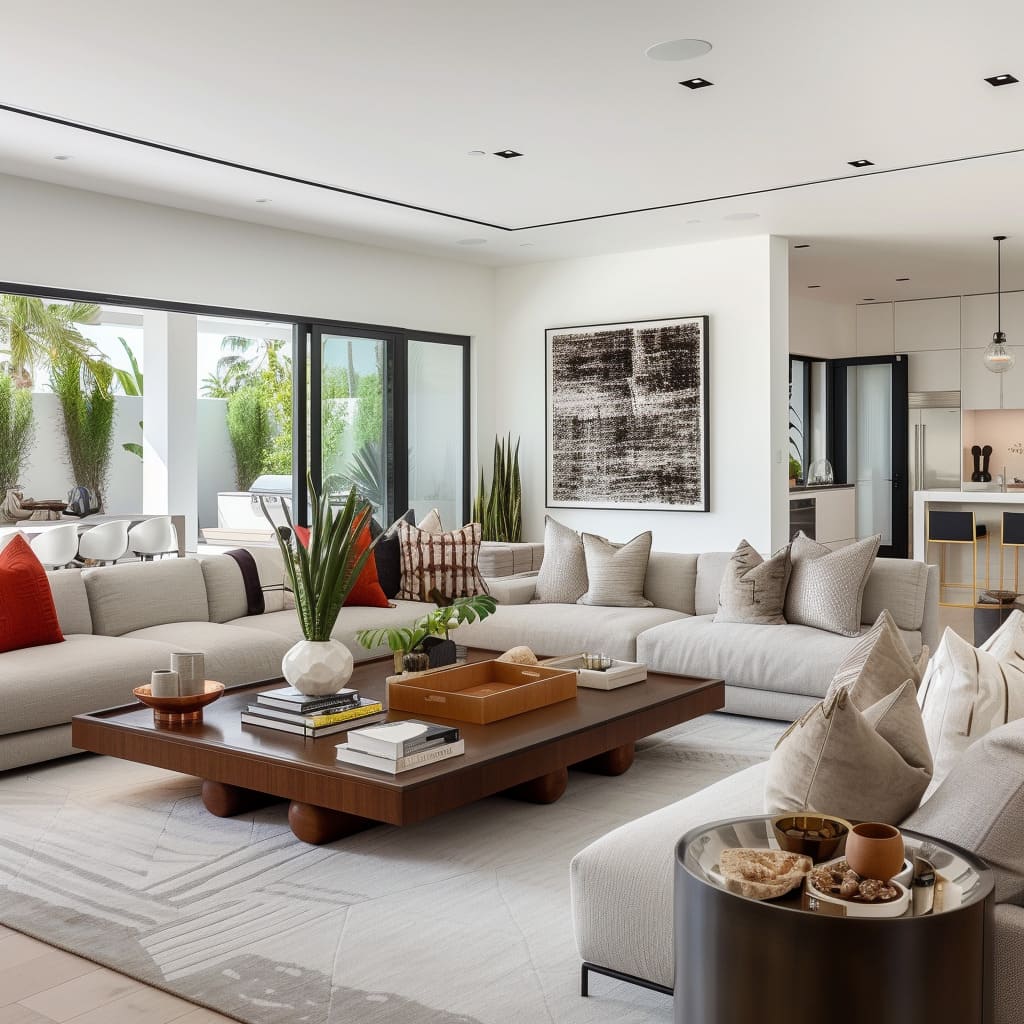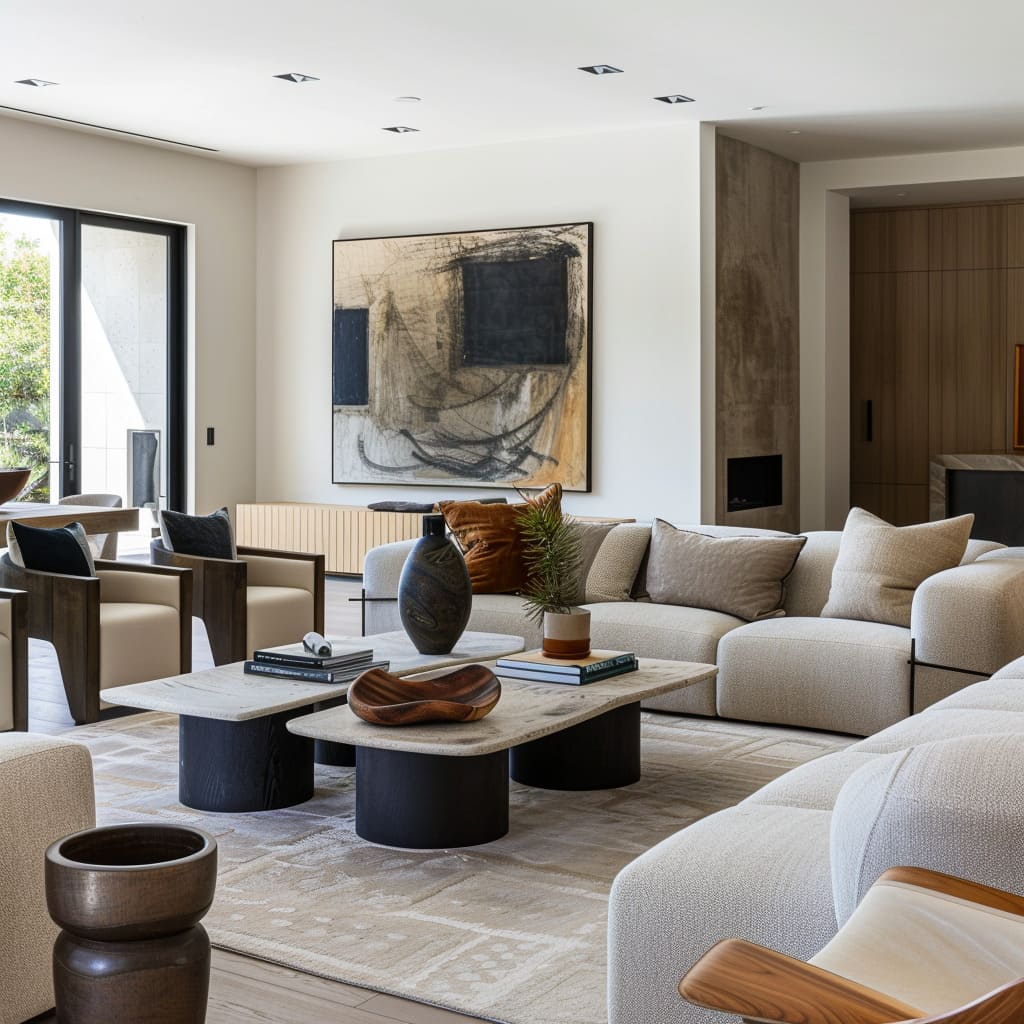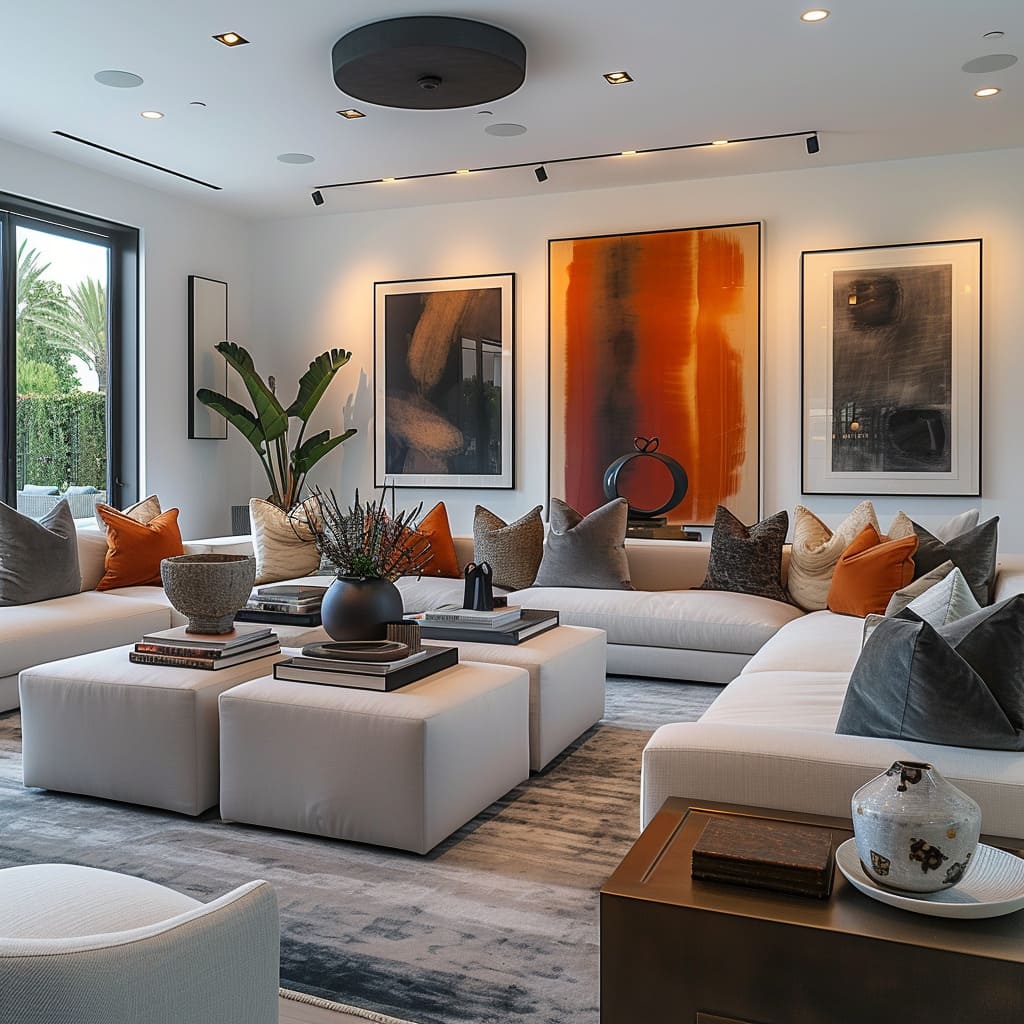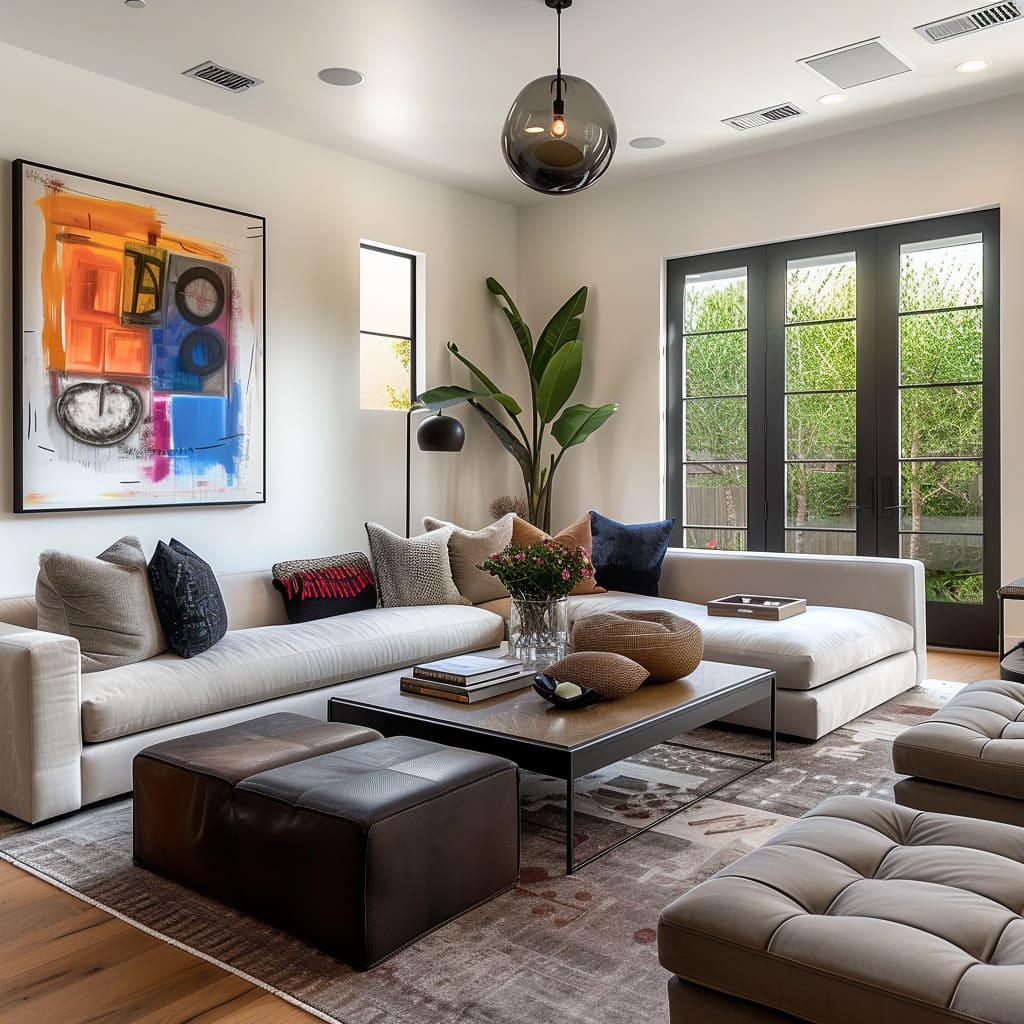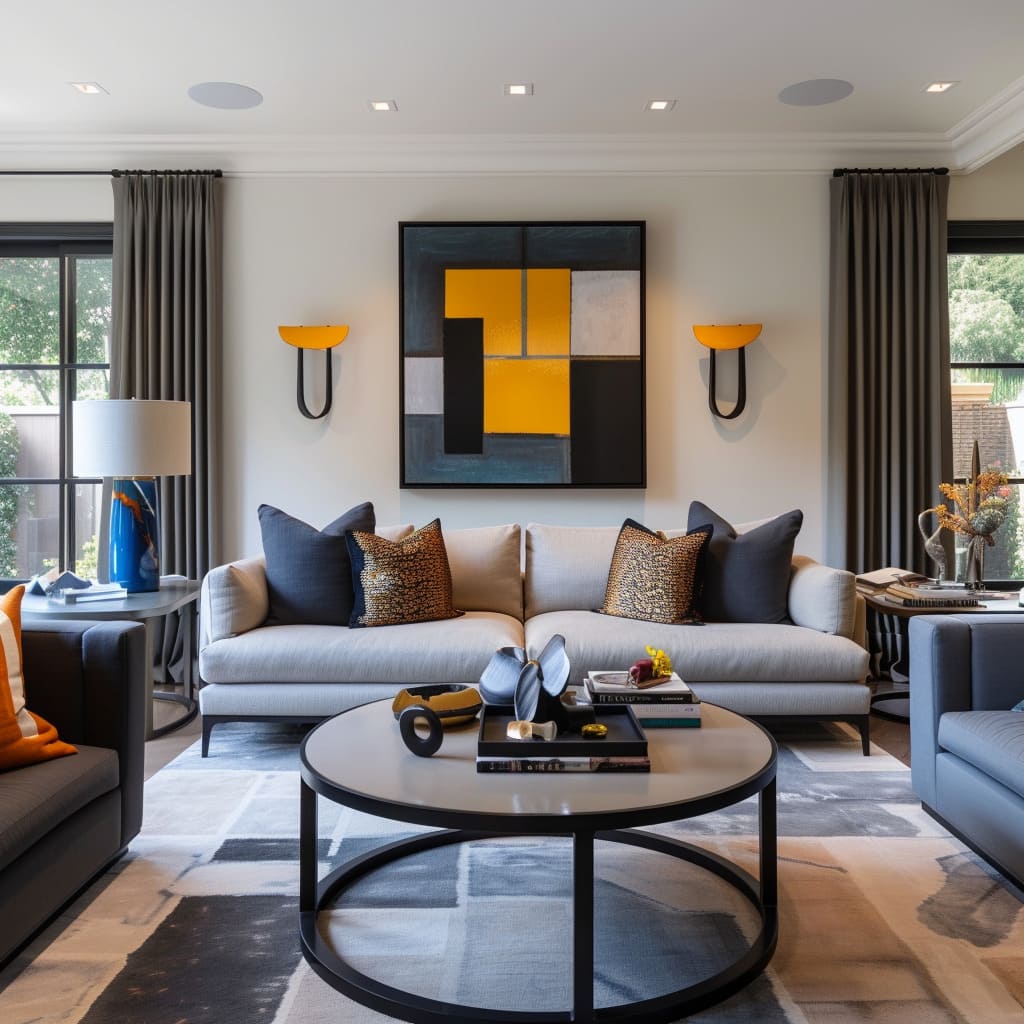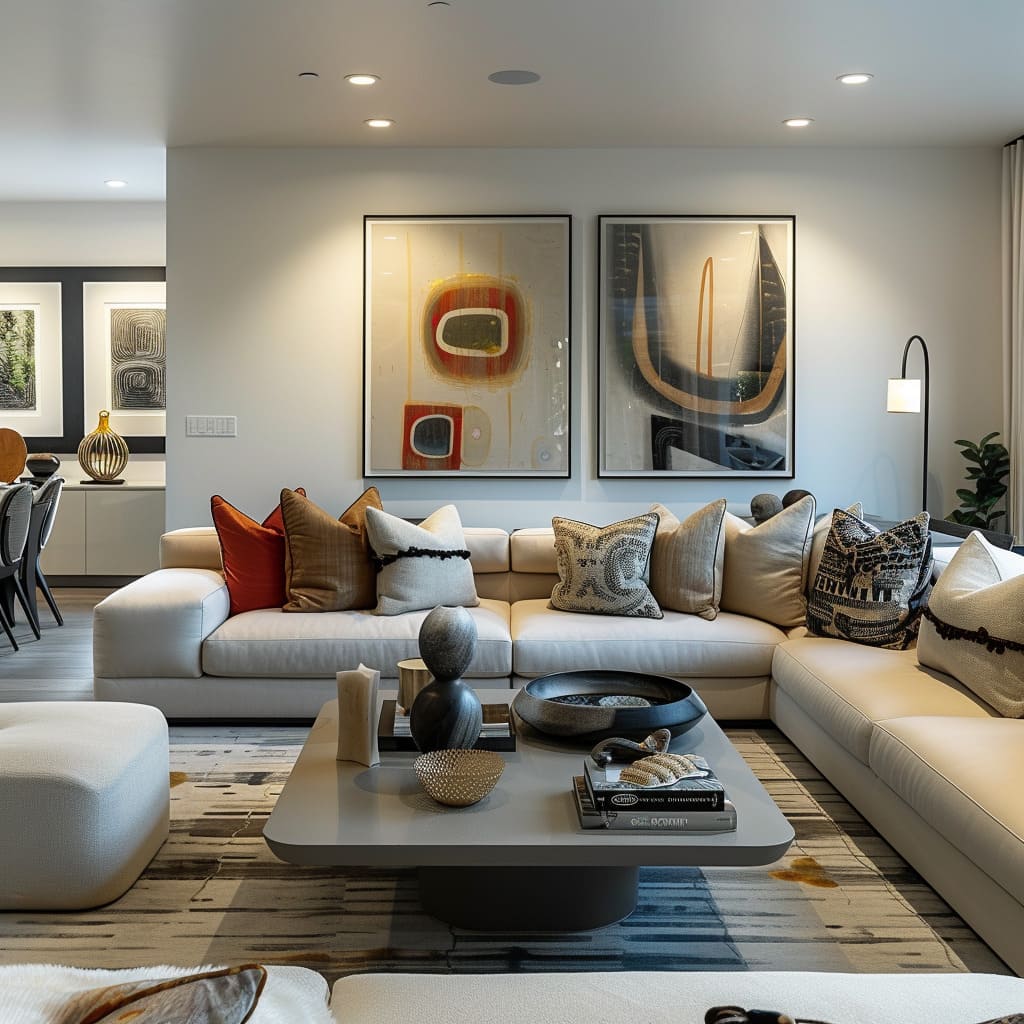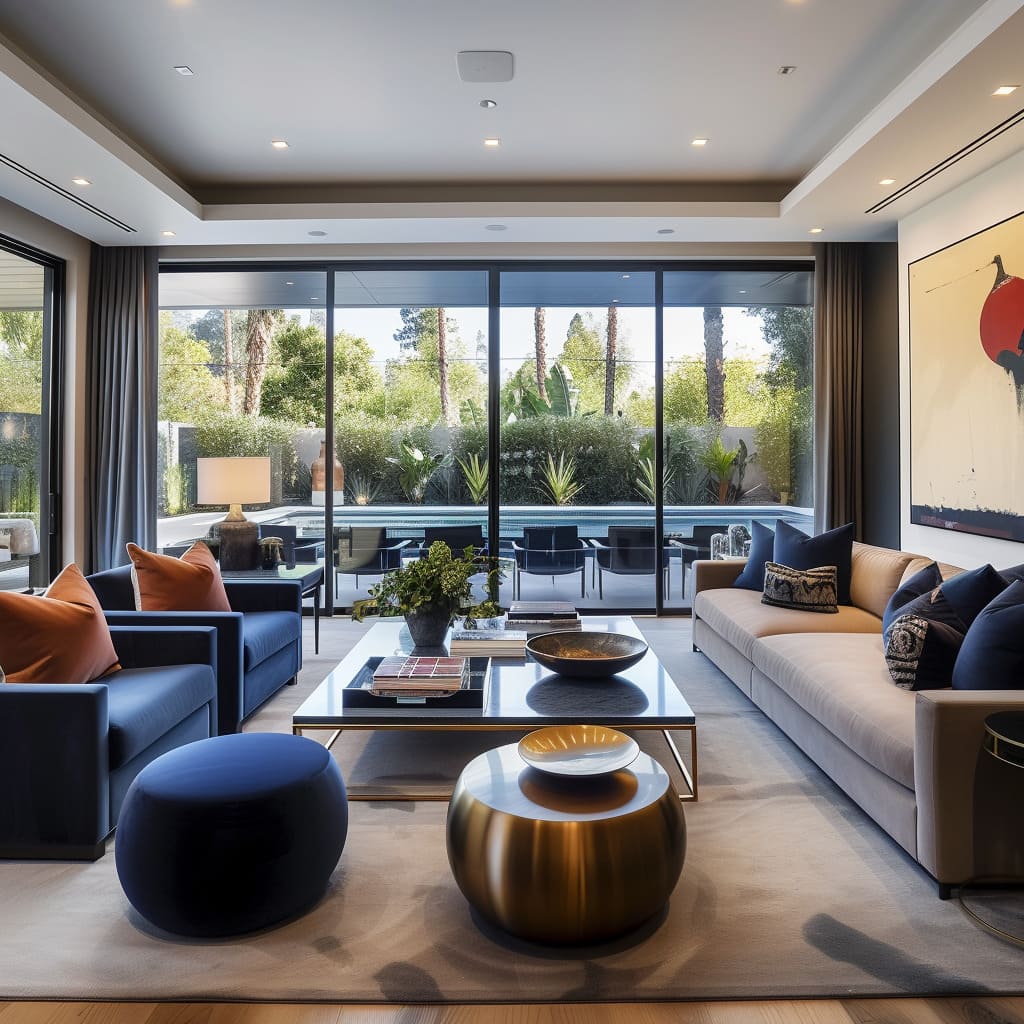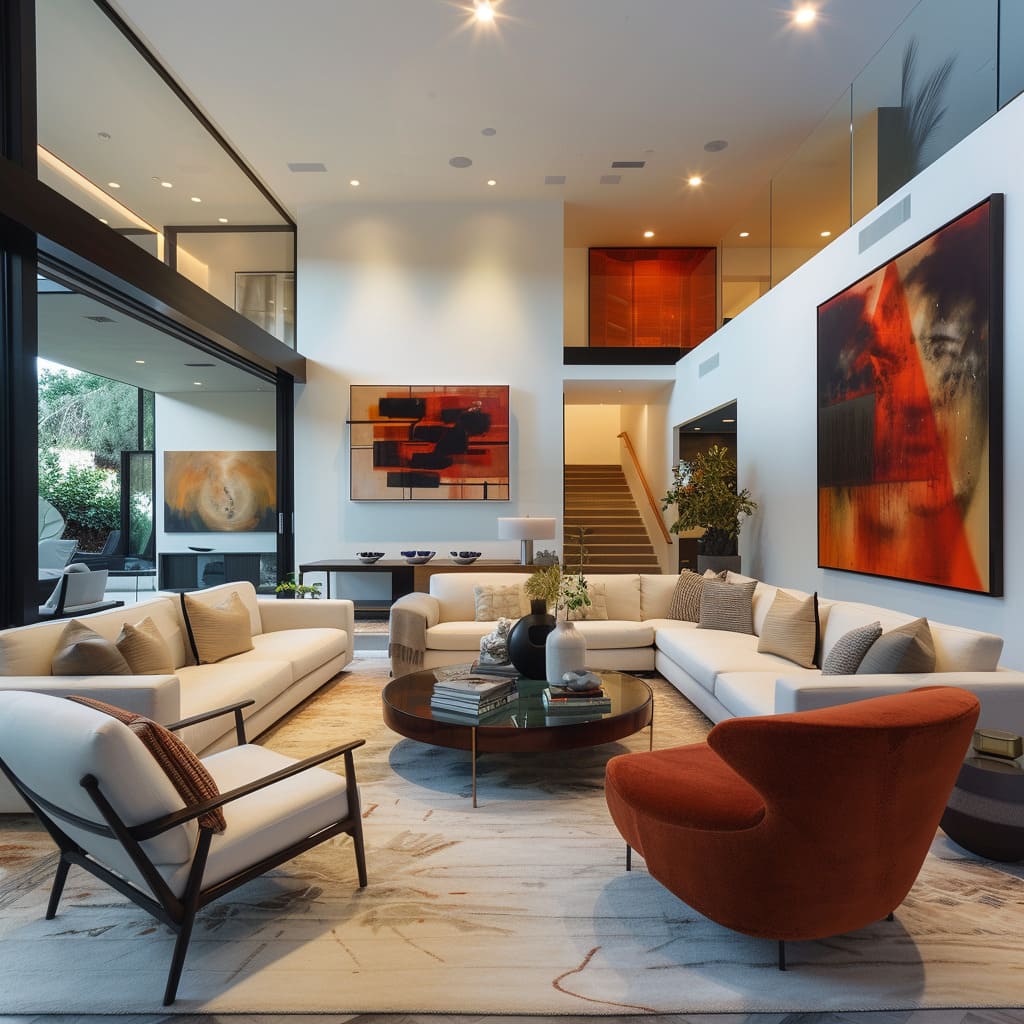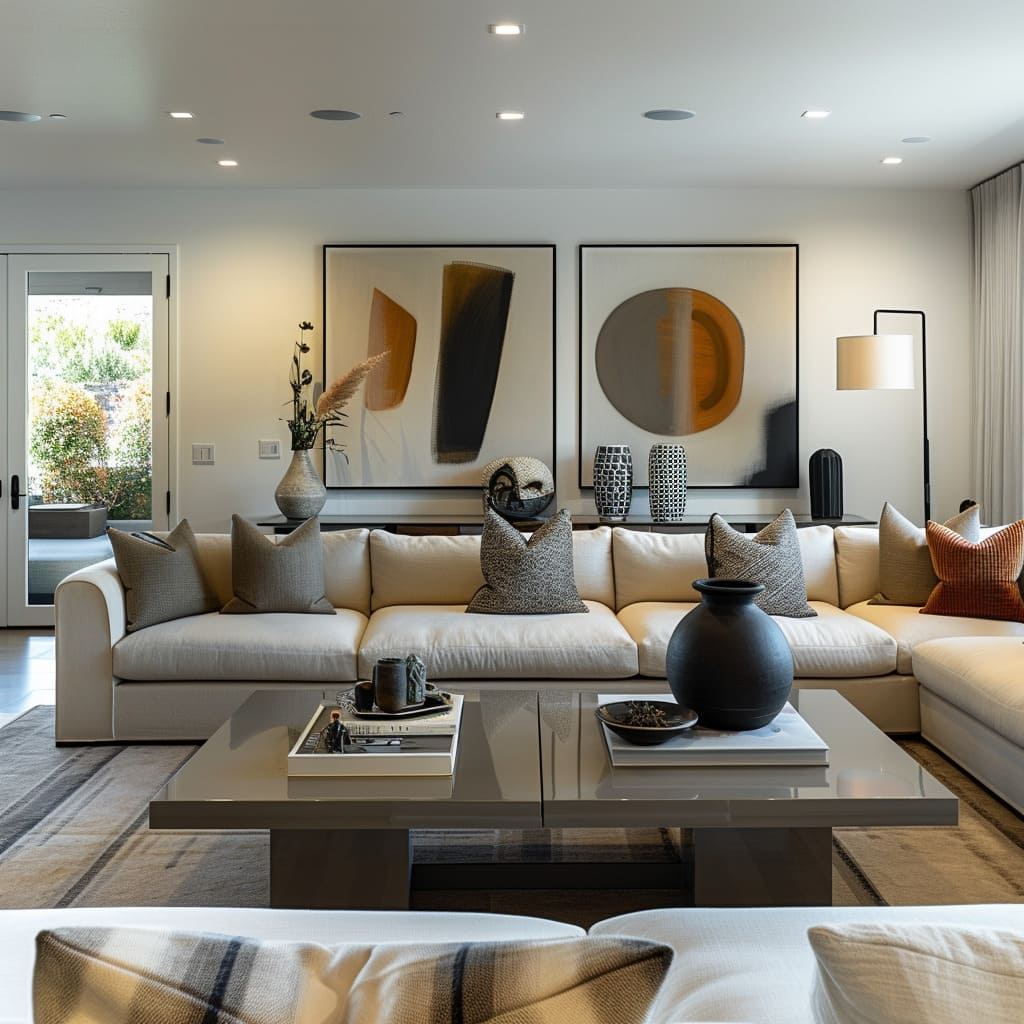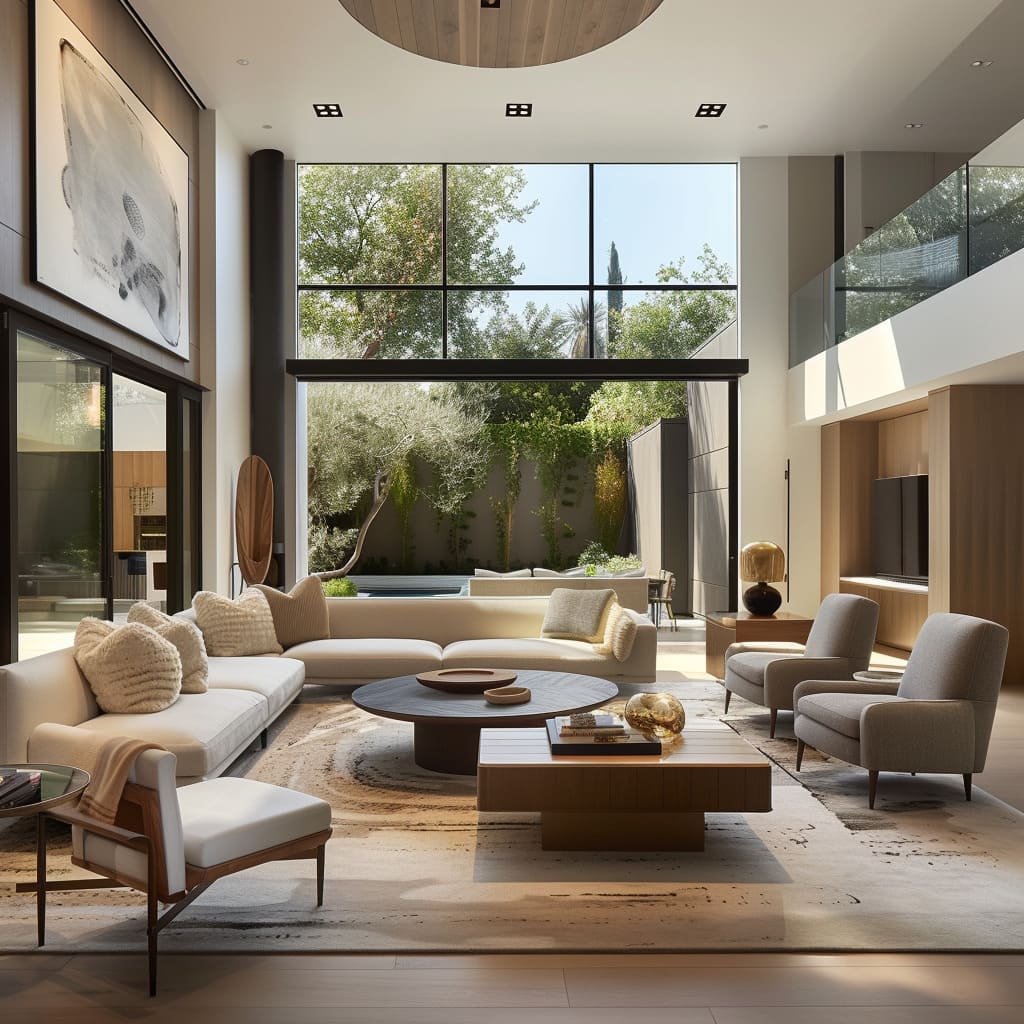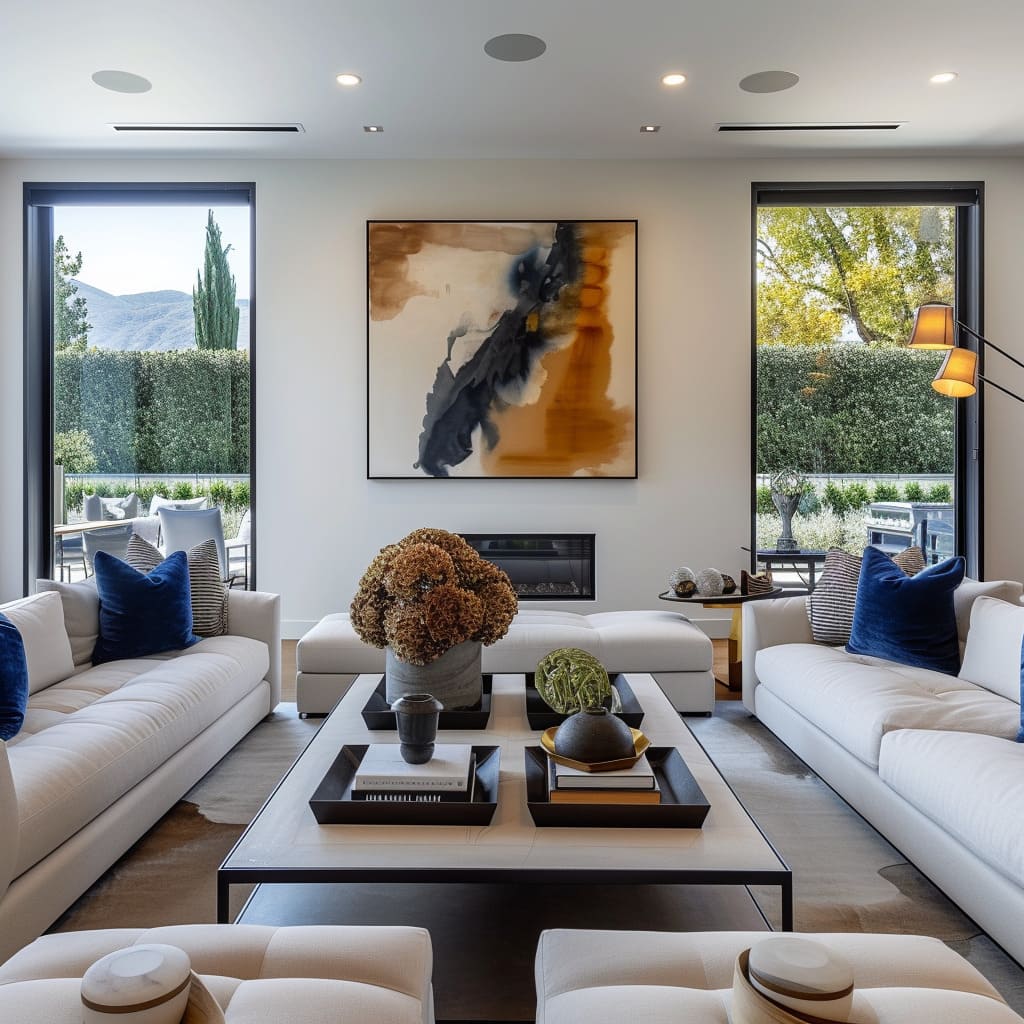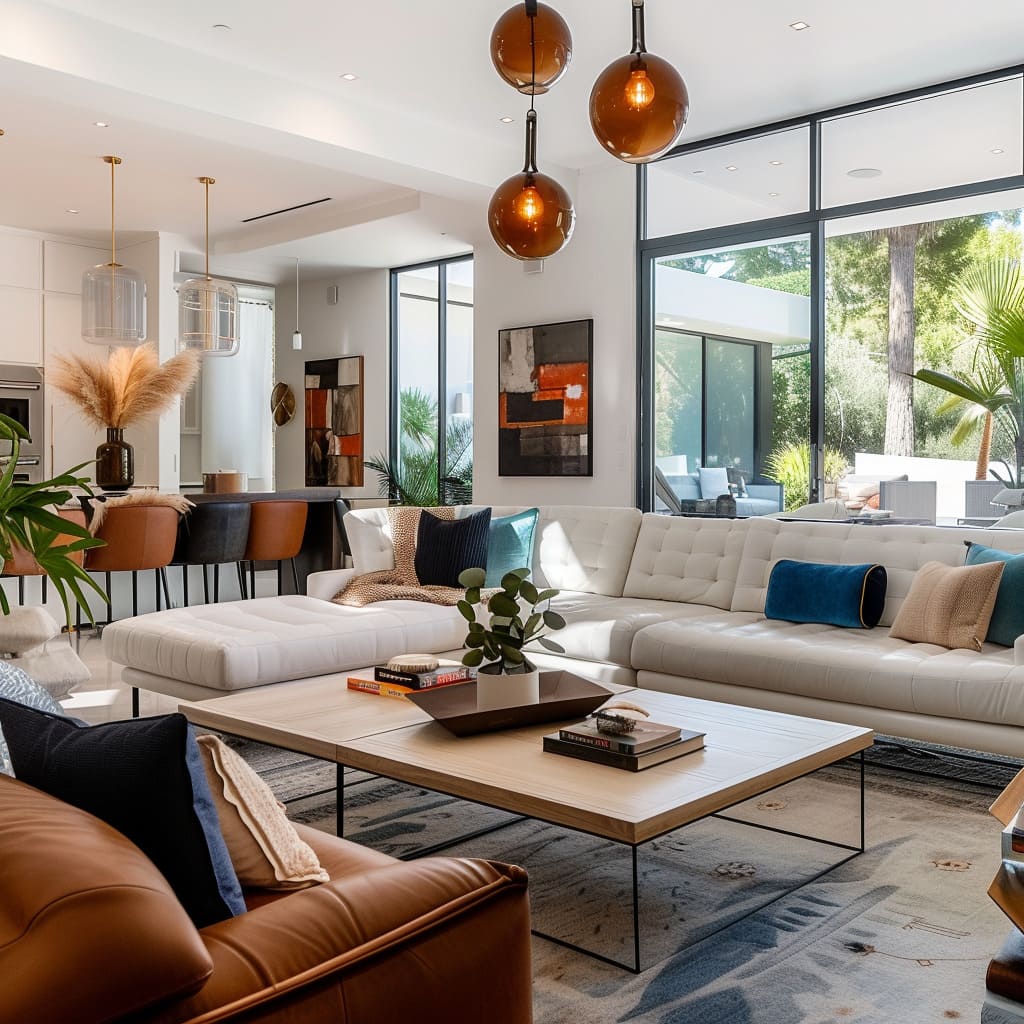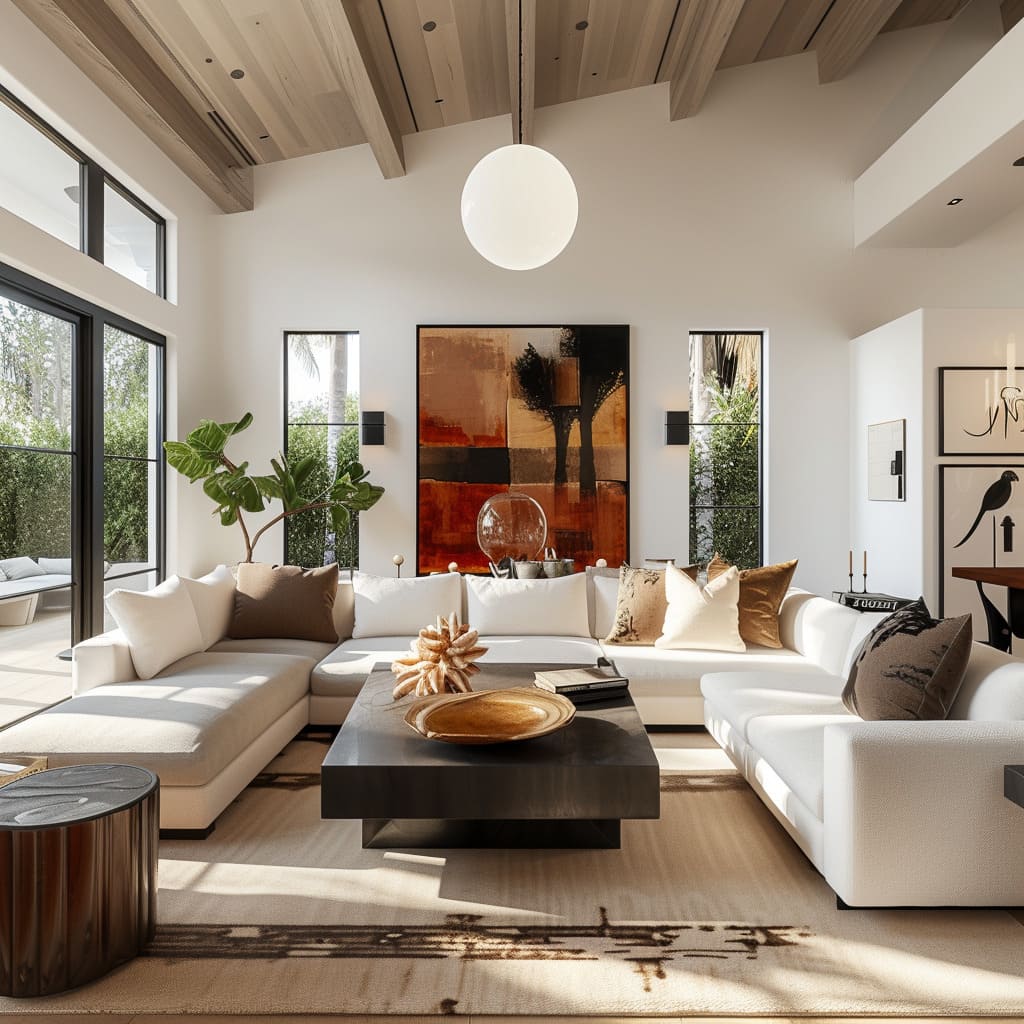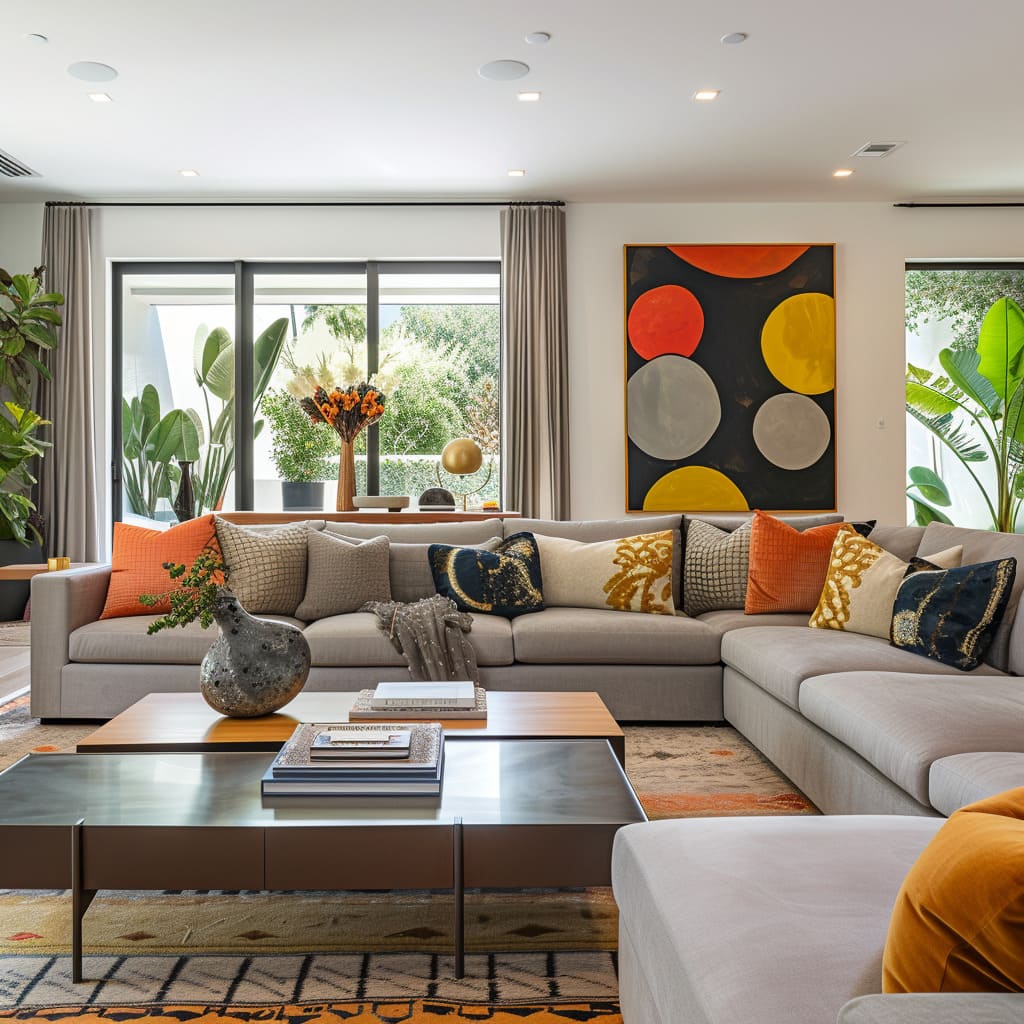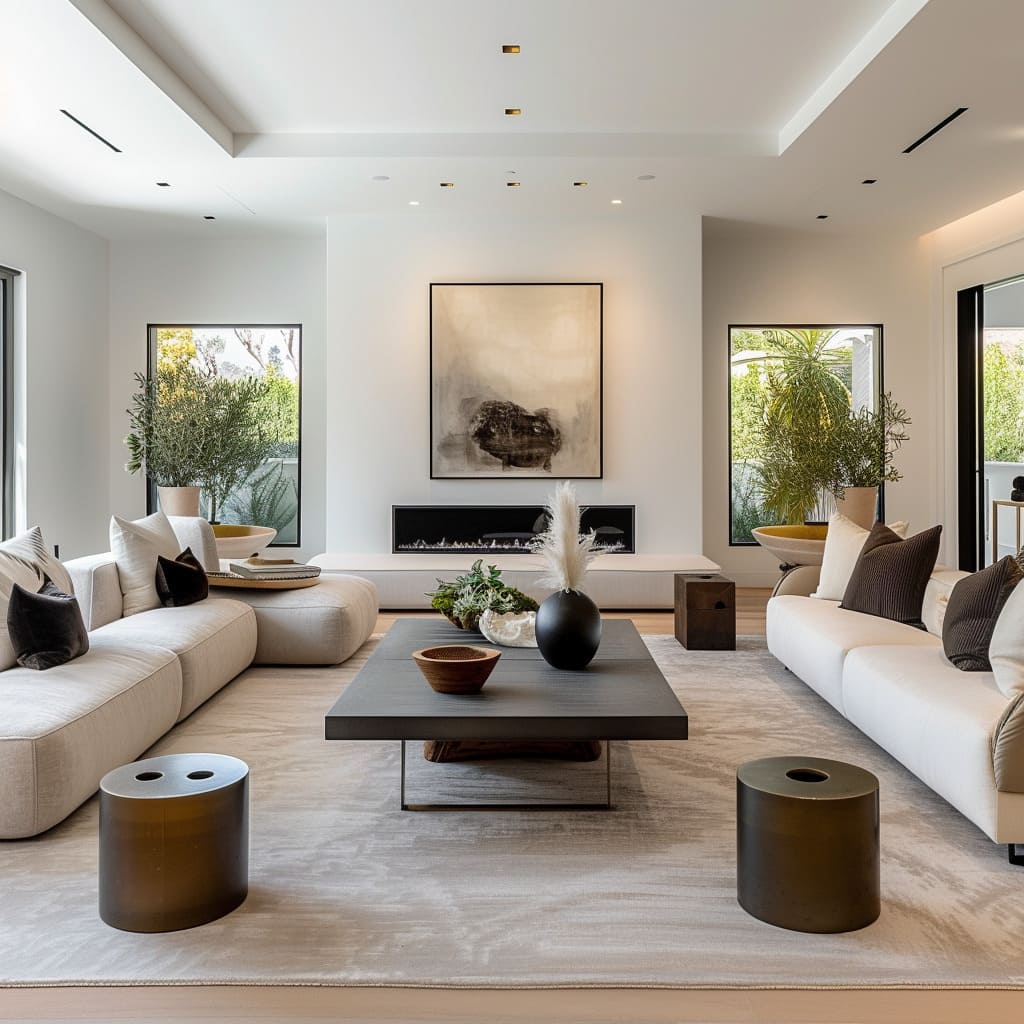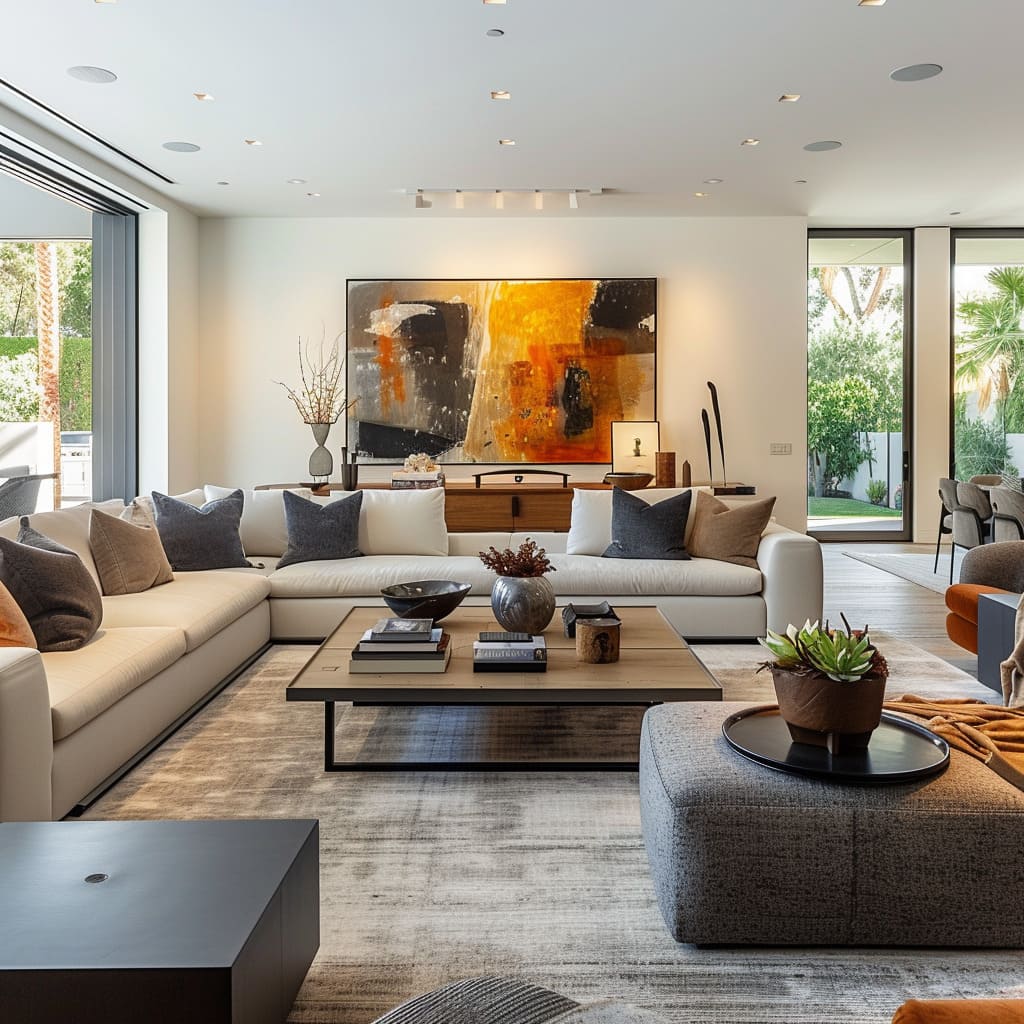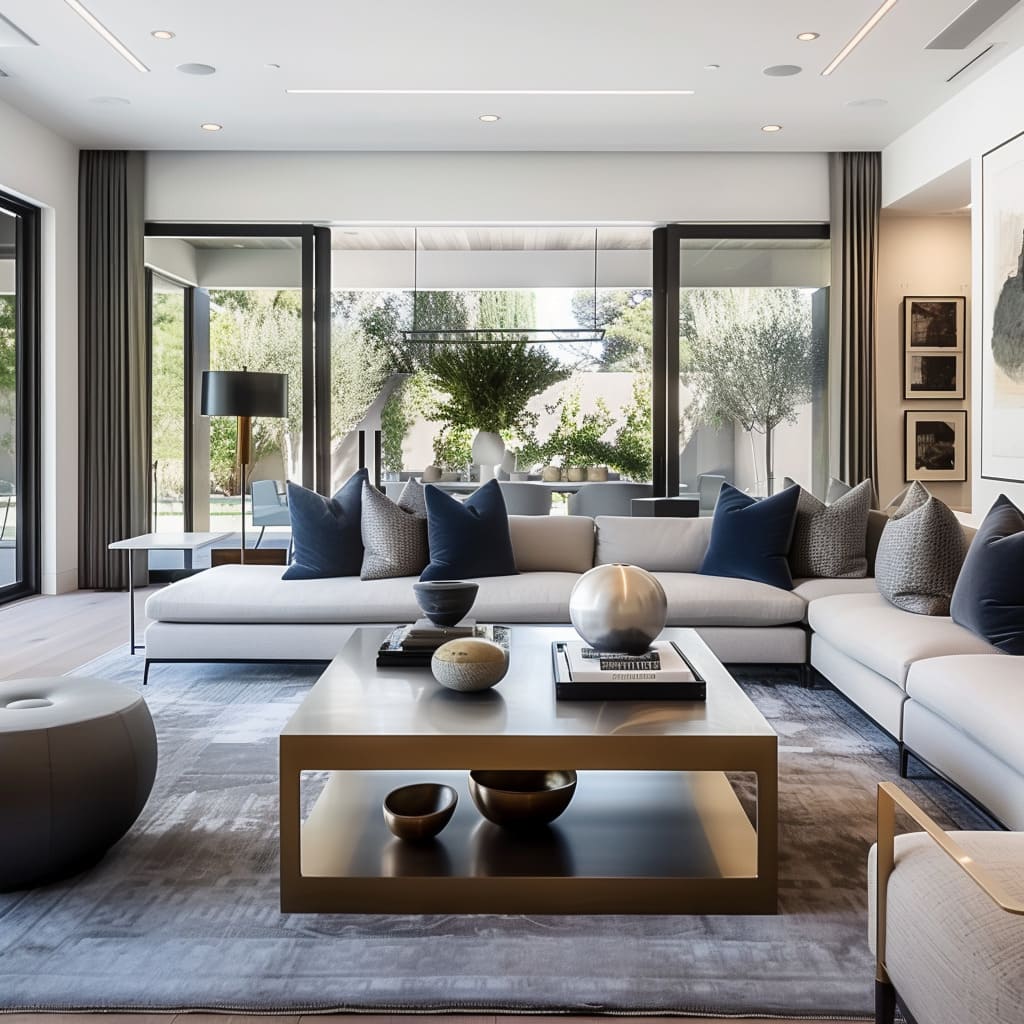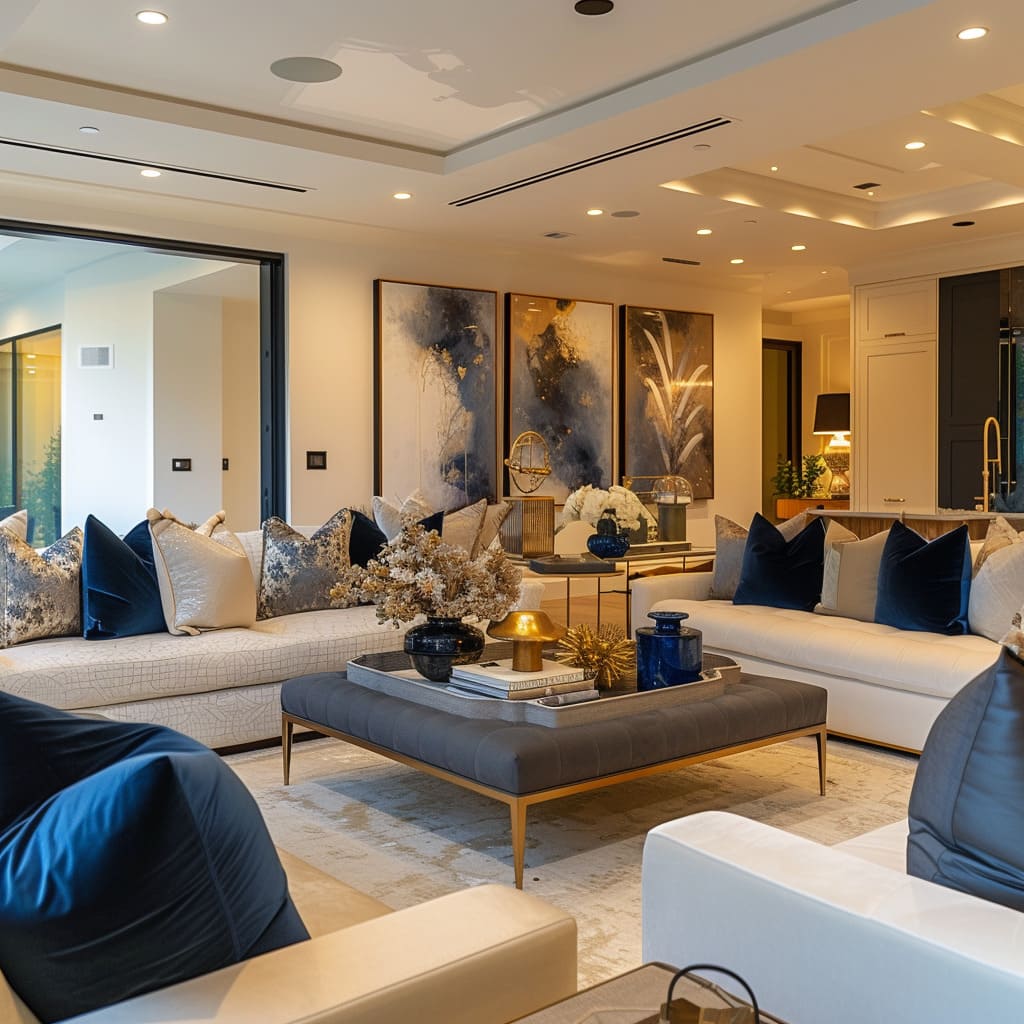Here aesthetics meet functionality, and comfort converges with style. In this article, we explore the intricate tapestry of design elements that define modern luxury living spaces.
From the understated elegance of a neutral color palette to the bespoke integration of the latest technologies, each aspect of interior design is crafted to create an ambiance that is both visually captivating and inherently livable. We will delve into how clean lines and natural light work together to sculpt spaces that are as open and fluid as they are cozy and intimate, and how the subtle interplay of textures and colors can transform a house into a sophisticated sanctuary.
Space and Form
We delve into the world of clean lines and open concepts, where each element is a testament to the beauty of simplicity. Artistic elements and geometric decor come together with sophisticated simplicity, showcasing the transformative power of well-defined spaces.
Clean Lines
The furniture and decor in these interiors boast clean, simple lines that underscore a sleek and modern aesthetic. Couches and chairs with streamlined forms and minimalistic frames not only contribute to a contemporary look but also ensure that the pieces are timeless, transcending fleeting trends.
The tables, whether coffee or side, often feature geometric shapes and a lack of ornate detailing, which reinforces the modern vibe. In terms of decor, less is more; there are no unnecessary embellishments, and each item seems purposeful, contributing to the orderly and uncluttered appearance.
The clean lines are often seen in the architectural elements as well — for instance, in the straight edges of windows and doorways, or in the crisp lines of built-in shelving and cabinetry.
Open Concept
The open concept design is a hallmark of these spaces, fostering not just a physical sense of openness but also a social one, where the living, dining, and kitchen areas merge into a single, cohesive space. This layout supports a modern lifestyle that values flexibility, accessibility, and a sense of community within the home.
Visual continuity is maintained through consistent flooring and a harmonious color scheme, allowing each area to flow naturally into the next. Structural elements like beams or changes in ceiling height subtly delineate spaces without the need for walls, preserving the openness while giving each area its sense of place.
Artistic Elements
Art plays a pivotal role in these interiors, with each piece carefully selected to complement the design scheme while also standing out as a focal point. The large paintings and sculptures often feature bold strokes or intriguing subjects that draw the eye and invite contemplation.
These artistic elements are strategically placed in the room to create visual anchor points, such as above a fireplace or as the backdrop to a seating arrangement. The art is not just decorative but also conversational pieces that reflect the homeowner’s taste and add a layer of personalization to the spaces.
Geometry in Decor
The use of geometric patterns and shapes in decor items such as rugs and pillows introduces a sense of harmony and rhythm to the space. This design choice speaks to a mathematical precision that’s both cerebral and aesthetic.
Patterns, whether bold or subtle, interweave complexity with unity, leading the eye across the room and creating a dynamic that is both engaging and comforting. The geometric motifs echo the structure and planning of the space itself, bridging the gap between abstract design and lived experience.
Sophisticated Simplicity
Simplicity in design often belies a sophisticated undercurrent that speaks volumes through a less-is-more approach. This design philosophy strips back the unnecessary, allowing the essential beauty of the materials and form to stand out.
In a space that favors sophistication through simplicity, every element is considered and purposeful. The clean lines, muted color palettes, and uncluttered surfaces result in a tranquil environment where each piece of furniture and decor has room to breathe, enabling inhabitants to live within the space without visual overwhelm.
Texture and Materials
These are contemporary interiors where textures speak volumes and materials define luxury. In this section, we celebrate the diverse touchpoints of design, from the plush comfort of rich fabrics to the cool sophistication of marble and stone.
Experience the allure of layered textures and the impact of premium finishes in creating sumptuous living environments.
Texture Variety
In these designs, texture plays as important a role as color, providing depth and contrast that appeal to the senses. A variety of fabrics are on display, from the smooth, cool touch of leather to the warm, inviting feel of woven textiles on throw pillows and upholstery.
Rugs with rich patterns or plush pile add another layer of texture underfoot, complementing the sleekness of hardwood or polished concrete floors. Even the accessories — from glossy ceramics to rough-hewn wood — are chosen for their tactile qualities, adding to the room’s layered and lived-in feel.
These textures are not just for aesthetics; they’re also about comfort and making the space inviting to touch and use.
Layered Comfort
The living spaces exhibit a masterful layering of comfort through a variety of seating options and textiles that create a deeply inviting atmosphere. Sofas are adorned with plush, oversized cushions that invite lounging and relaxation.
In addition to the primary seating, supplementary ottomans and plush chairs are arranged to facilitate intimate conversations, while also allowing for personal space. The textiles range from smooth, soft fabrics on the sofas to woven throws and textured rugs underfoot, each layer building upon the next to create a tactile experience that is both luxurious and comforting.
Throw pillows in a mix of sizes and fabric types add dimension and visual interest to the seating areas.
Blending of Textures
These interiors showcase a rich blend of textures that engage the senses and add depth to the visual landscape. Natural wood surfaces provide warmth and an organic touch, while metal and glass elements offer cool contrast and a contemporary edge.
The juxtaposition of textures is carefully orchestrated, with rough against smooth, matte against shine, and rigid against soft, to create a dynamic yet harmonious experience. Fabrics range from fine, lightweight linens to heavier, textured weaves, contributing to the layered effect and sensory richness of the space.
Luxury Finishes
High-end finishes are the hallmarks of luxury and signify a space that’s been carefully curated with quality and elegance in mind. Materials such as marble or polished stone are not just finishes; they are statements of timeless sophistication.
The sheen and texture of these materials add depth and richness to the space, creating an atmosphere of opulence. Whether it’s the gleaming floors that reflect the light, or the countertops that serve as a canvas for daily life, these surfaces are as functional as they are beautiful, proving that luxury is not only seen but lived.
Accent and Detail
Enter a world where details are not mere additions but the essence of design. Here, metallic accents add a touch of finesse, ornamental plants infuse vitality, and strategic lighting casts a warm glow on harmonious blends of decor.
In this section, we delve into the subtleties that complete the contemporary design narrative, creating spaces that resonate with personality and grace.
Strategic Lighting
The lighting in these spaces is thoughtfully planned, combining the functional need for illumination with the aesthetic goal of creating the right mood. Recessed ceiling lights provide a soft, ambient glow, while statement light fixtures serve as both sources of light and sculptural elements.
Pendant lights and chandeliers are often centered over key areas like dining tables or living room centers, drawing the eye and adding to the room’s hierarchy of design elements. Task lighting, such as floor lamps beside reading chairs or table lamps on desks, ensures that each area of the open space has its own atmosphere, adaptable to the needs of the moment.
Metallic Accents
Metallic accents provide a recurring theme of refinement and sophistication within each room. Polished chrome, brushed brass, and other metal finishes catch the light and draw the eye to the craftsmanship of the fixtures and decor accents.
From the sleek lines of metal table legs to the more ornate detailing on lighting fixtures, these elements add a consistent thread of elegance throughout the space. The shine of the metals is balanced by their placement; they serve as highlights rather than focal points, ensuring the overall design remains cohesive and grounded.
Ornamental Plants
Incorporating greenery into the interior design brings in a breath of fresh air and a dash of color that’s both calming and invigorating. The presence of plants, whether a sculptural statement piece or an arrangement of foliage, adds a natural touch that can soften the modern lines of a contemporary space.
Plants are chosen not just for their aesthetic appeal but also for their ability to enhance the room’s atmosphere, purifying the air and connecting the indoors to the outdoors. They become living decor that changes with the seasons and grows with the space.
Harmonious Blends
A well-designed room balances various elements without allowing any single one to dominate. Furniture, textiles, color palettes, and decor come together in a symphony of design that feels intentional and cohesive.
This harmony is achieved through careful consideration of scale, color, texture, and form, ensuring that each piece complements the others. The result is a space that feels complete and inviting, where the eye can move seamlessly from one area to another, finding delight in the details that together make the whole.
Subtle Patterns
While minimalist design and neutral color schemes are characteristic of these interiors, subtle patterns play an essential role in adding texture and visual interest without overwhelming the space. Whether through a fine herringbone weave in a throw pillow, a faint chevron in a rug, or an understated geometric print on the walls, these patterns provide a layer of complexity that enlivens the environment.
They work to draw the eye, adding depth and contrast to otherwise monochrome or solid elements, and they serve to tie different components of the room together in a quiet yet compelling fashion.
Cohesive Theme
The art of creating a cohesive theme throughout a home lies in the subtle repetition of materials, color palettes, and stylistic choices across different rooms. This doesn’t mean every room is a carbon copy of the next, but rather that there’s a red thread connecting the spaces.
For instance, a particular wood finish or accent color might reappear in various forms, from the kitchen cabinets to the picture frames in the living room, or a signature design element, like a curve or angle, is echoed in furniture shapes and architectural details. This continuity builds a sense of unity and flow throughout the home, making it feel harmonious and thoughtfully curated.
Color and Light
Dive into the essence of contemporary design where color and light intersect to create enchanting atmospheres. Here, we explore how neutral color palettes form tranquil backdrops, while bold accents add character and vitality.
Discover how natural light and reflective surfaces work in concert to elevate these serene spaces into vibrant settings for modern living.
Neutral Color Palette
The use of neutral tones in these designs not only creates a serene and sophisticated backdrop but also ensures that the spaces feel calm and expansive. The nuanced palette of beiges, greys, and whites offers a canvas where the architectural details and natural light can play a significant role.
In these interiors, the walls often exhibit a soft, muted tone, serving as a perfect backdrop for artwork and allowing for the other colors and textures in the room to stand out. The flooring, whether it’s polished stone or soft carpeting, usually echoes these neutral hues, contributing to the seamless aesthetic flow from one space to another.
Bold Accent Colors
The sparing use of bold accent colors serves as a dynamic contrast to the overall neutral scheme. Strategic pops of orange, blue, and mustard are seen in throw pillows, artwork, and decorative pieces, invigorating the rooms with a lively energy.
These colors are not just random but are carefully chosen to evoke certain moods or to draw attention to particular areas of the room, such as a reading nook or a focal art piece. In some spaces, the accent colors are mirrored in subtle details like book covers, vases, or even in the blooms of a tastefully placed floral arrangement, thereby tying the whole room together in a visual symphony of color.
Natural Light
These interiors are bathed in an abundance of natural light, thanks to the large, often floor-to-ceiling windows that frame the outdoor scenery, effectively bringing the outside in. The strategic placement of these windows and sliding glass doors not only maximizes the view but also harnesses daylight to highlight the room’s textures and colors.
During the day, the natural light shifts the ambiance of the space subtly, reflecting off metallic accents and glossy surfaces to create a living environment that responds to the time of day. The effect is a space that feels airy and fresh, enhancing the occupants’ connection to nature and the world beyond their walls.
Reflective Surfaces
Reflective surfaces are utilized throughout these interiors to amplify light and enhance the sense of space. Mirrored panels and high-gloss finishes bounce light around the rooms, making them appear larger and more open.
The reflective quality of these surfaces adds a touch of glamour and luxury, making the spaces feel sophisticated and designed with intention. Glass-top tables, mirrored accent pieces, and polished metals are interspersed with matte textures to create a balance, ensuring that the reflectivity enhances rather than overwhelms the room’s design.
Functionality and Lifestyle
Contemporary design is as much about functionality as it is about form, with each space crafted for modern living. Discover interiors where minimalist decor meets practicality, technology blends with comfort, and each arrangement encourages a connected lifestyle.
We explore how thoughtful design creates environments that are not only beautiful but also perfectly attuned to everyday life.
Minimalist Decor
The minimalist decor in these spaces is intentional, striking a balance between functionality and aesthetics. The rooms are not crowded with furniture, instead featuring carefully selected pieces that serve a purpose while maintaining a clean look.
Each item, from the sleek coffee tables to the understated sofas, is chosen for its form as much as its function, ensuring that nothing superfluous distracts from the room’s overall sense of calm. The minimalist approach extends to the accessories; bookshelves are not overstuffed, and side tables host just a lamp or a small collection of items, each curated to contribute to the design narrative without overwhelming the senses.
Indoor-Outdoor Connection
The design philosophy extends beyond the interior walls, with large windows and glass doors blurring the lines between inside and outside. This seamless transition to outdoor spaces is more than aesthetic; it reflects a lifestyle that values the interplay between home and nature.
Patios and outdoor seating areas are furnished to match the sophistication of the interior, with comfortable furniture and thoughtful landscaping. The natural light that floods in through the expansive windows further reinforces this connection, as do the plant life and natural materials that are visible both inside and out.
The result is a living space that feels expansive, integrated with its surroundings, and attuned to the rhythms of nature.
Spacious Seating Arrangements
Seating arrangements in these spaces are more than just functional; they’re crafted to foster social engagement and warmth. Furniture is thoughtfully arranged to invite conversation, create intimacy, and make room for shared moments.
Couches and chairs are positioned not just for optimal viewing of entertainment screens but to encourage eye contact, facilitate the flow of dialogue, and make every person feel included. In such arrangements, each seat is a place of comfort that offers a view of both the room and the company, reinforcing the idea that togetherness is at the heart of the design.
Functional Decor
Decor that doubles as functional embodies smart design. Books, vases, and artistic bowls not only serve a purpose but also contribute to the room’s visual story.
These items add a personal touch, reflecting the interests and style of the inhabitants. A stack of books can become a conversation starter, while vases can be the vessel for seasonal blooms, bringing in a splash of color and life.
Functional decor stands at the crossroads of practicality and aesthetic, proving that design can be both beautiful and useful.
Integrated Technology
Contemporary homes are distinguished by their seamless integration of technology, which enhances both functionality and aesthetic appeal. High-tech features are incorporated in such a way that they blend with the interior design, ensuring that the technology serves the user without disrupting the space’s style.
For instance, flat-screen televisions become part of the wall decor, smart lighting systems are managed via discreet panels, and speakers are often built into the ceiling or walls. These smart homes might also include automated window treatments that can be adjusted for light and privacy with the touch of a button.
The aim is to have technology on hand that simplifies life without imposing on the home’s beauty and tranquility.
Plush Upholstery
Comfort is key in contemporary interior design, with seating often featuring plush, inviting upholstery. Sofas and armchairs are dressed in soft, luxurious fabrics, such as velvets, chenilles, or high-grade leathers, encouraging relaxation and leisure.
Cushions are generously filled, and seating is designed to support and cocoon the body. These furniture pieces are not only visually appealing, but they also invite you to sink in and stay a while, offering a tactile experience that’s as satisfying as the visual harmony they contribute to the room.
In closing, the contemporary home is a celebration of refined taste and intelligent design. It’s a place where every element is in dialogue with the others, creating environments that are not only beautiful to behold but are also extensions of the individuals who inhabit them.
The marriage of plush upholstery with sleek, clean lines; the strategic placement of ornamental plants alongside integrated technology; and the thoughtful infusion of bold accent colors within a neutral setting, all embody a design philosophy that prizes harmony and balance. By weaving together these various strands — neutral and vibrant, organic and geometric, plush and sleek — contemporary interior design achieves a symphony of spaces that are as much about living well as they are about living beautifully.

